(完整word版)小学定冠词和不定冠词练习题
中小学语法大全之冠词a-an-the-及专项练习题--答案
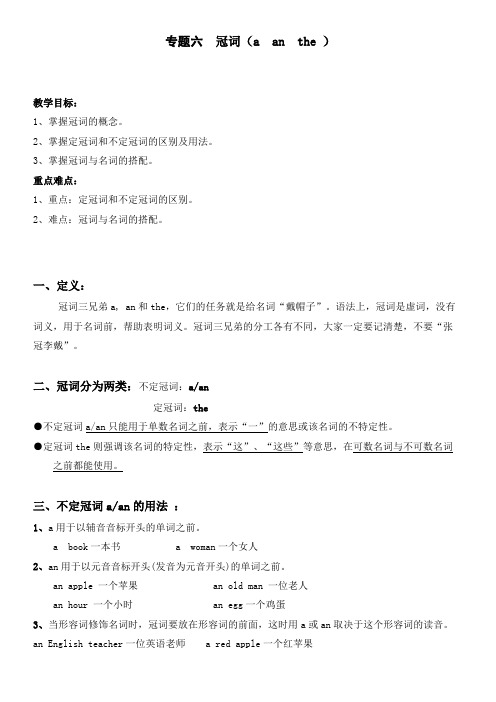
专题六冠词(a an the )教学目标:1、掌握冠词的概念。
2、掌握定冠词和不定冠词的区别及用法。
3、掌握冠词与名词的搭配。
重点难点:1、重点:定冠词和不定冠词的区别。
2、难点:冠词与名词的搭配。
一、定义:冠词三兄弟a, an和the,它们的任务就是给名词“戴帽子”。
语法上,冠词是虚词,没有词义,用于名词前,帮助表明词义。
冠词三兄弟的分工各有不同,大家一定要记清楚,不要“张冠李戴”。
二、冠词分为两类:不定冠词:a/an定冠词:the●不定冠词a/an只能用于单数名词之前,表示“一”的意思或该名词的不特定性。
●定冠词the则强调该名词的特定性,表示“这”、“这些”等意思,在可数名词与不可数名词之前都能使用。
三、不定冠词a/an的用法:1、a用于以辅音音标开头的单词之前。
a book一本书 a woman一个女人2、an用于以元音音标开头(发音为元音开头)的单词之前。
an apple 一个苹果 an old man 一位老人an hour 一个小时 an egg一个鸡蛋3、当形容词修饰名词时,冠词要放在形容词的前面,这时用a或an取决于这个形容词的读音。
an English teacher一位英语老师 a red apple一个红苹果4、用于第一次提到的、不确定的人或物(可数名词)之前:There is ______dog outside the door 外面有一条狗。
Do you see ______man in red T-shirt?你有看到一个穿红T恤衫的男子吗?5、表示职业、身份:a lawyer一个律师 a doctor 一个医生 a student一位学生6、用于数字、量词之前:a hundred 一百 a lot of 许多 a pair of 一双7、用于一些固定词组中:have a rest休息 go for a walk 散步四、定冠词the的用法定冠词的一般用法:1、用于第二次谈到的人或物。
小学英语(完整版)冠词句型专项练习含解析

小学英语(完整版)冠词句型专项练习含解析一、选择题1._____ great progress he has made! I really think it’s _____ great success.A.What a; 不填B.What; aC.How; a D.What; 不填2.—Is this ________ new computer your mother gave you as your birthday present?—Yes. I have never seen ________ better one before.A.the; a B.a; a C.a; the D.the; the3.---Excuse me, is there ________ book by Mo Yan?---Yes. It’s on _________ bookshelf over there.A.a; / B.a; the C./; the D.the; a4.—What would you like to be when you grow up? —host like Zhu Jun.A.A B.An C.The D./5.—Do you think it’s ______ good fruit juice advertisement?—Of course. I can’t wait to try ______ bottle of it.A./; a B.a; a C.a; the D./; the6.─ How far is it from this hotel to station?─ It is eleven-kilometer walk from here.A.the; an B.the; a C.a; an D.a; the7.—Jim took ___ one-hour ride just now. What a short time he spent finishing such a long way!—He is ______ experienced rider.A.an; the B.a; the C.a; an D.an; a8.Tiger Watch, _______ 80-minute documentary, won_______ award for its amazing photography.A.an; an B.an, aC.a, an D.the; a9.— Tu Youyou who won the Nobel Prize in Physiology or Medicine in 2015 is ______ excellent Chinese scientist.—I can’t agree more. In fact, she is _______ pride of China.A.the; a B.an; the C.an; a D.the; the10.This is ______ unusual course that is taught in ______ university, but it’s of no use to the real life.A.an, a B.an, an C.a, an D.a, a 11.——Pass me _____________ magazine on the shelf,please,Jim.——But it’s not ____________ new magazine,Dad. You have already read it,haven’t you?A.the ;a B.the ;the C.a;a D.a; the12.Little Tommy wants to be ________ English teacher when he grows up.A.a B.an C.the D./13.—Don’t you think Huawei company is ________ success?—Yes, I do. Huawei smartphones are popular among ________ public in China.A.the; a B.a; the C.a; a D./; the14.________ 84-year-old man was attacked while walking in San Francisco. More than________ of the population in this city is Asian.A.A; one-third B.An; one-third C./; one-third D.An; two-third 15.The year 2021 marks ________ beginning of China’s l4th Five-year Plan period.A.a B.the C.an D./16.Caoxian county—________ tiny little-known inland county in ______ East China’s Shandong Province, became famous overnight.A.a; the B.a; / C.the; at D.the; / 17.According to the picture, the Communist Party of China has a history of hundredyears.A.a B.an C.the D./18.Almost all the people in Binhai, our hometown, work hard to make it ________ better place. A.a B.an C.the D./19.Now, beginning in August, ________ new train line runs from Beijing across ________ Silk Road.A.a; the B./; the C.the; a D.the; /20.There is ______ “l” in the word “apple”.A.a B.an C.the D./21.- Have you ever seen ______ Chinese movie Wolf Warriors 2 ?-Sure . It’s such an exciting film that I want to see __________second time.A.the; a B.an; / C.a; a D.the; the 22.—Who’s ________ girl in red over there?—Kate, ________ excellent student in our class.A.the; a B.the; an C./; an D./; a23.Jessie J comes from _______ European country. She is taking part in _______ TV show I Am A Singer.A.a; the B.an; / C.the; the D.an; the24.—I hear there’ll be ________talk to teenager problems next Monday?—Do you mean________talk our teacher asked us to listen to ?A.a; the B.a; a/ C.the; the D.the ; a /25.---Do you know the TV programme called 24 Hours?---Oh, it is one-hour news round-up on CCTV.A.a B.an C.the D./ 26.Christopher Columbus, ______ explorer, came from ______European country.A.an/an B.an/a C.the/ a D.the/an 27.—President Xi gave ________exciting speech on TV on the evening of Dec.31,2019.— Yes. What______ great progress we Chinese made last year!A.an; a B./; a C.an; / D./; /28.Life is full of _____ chances, but they're not always _____ ones we hope for.A./; the B.the; the C./; / D.the; /29.In _____ eyes of some children, playing on the Internet can only bring them______ fun. A.the; a B./; a C.the; / D./; /30.To save time, many students have _________ lunch at school every day.A.a B.an C./ D.the 31.Thailand is ________ Asian country and it is a good place to visit.A.a B.an C.the D./32.--There will be a new railway station in Jintan. _______ exciting news!--- Yes, it is_____ great help to us. And we’ll have another choice for travelling.A.What; a B.What an; the C.What an; a D.What; the33._____ Nantong today is more beautiful than before.Mr.Jackson said he would visit it ____ third time.A.The ; a B.The ; the C./; the D./; a34.I didn't do my best . Could you give me second chance, please?A.an B./ C.the D.a35.The film Coco is big success that many people go to the cinema to watch it.A.such B.such a C.so D.so a36.–Sorry, I broke your glass by _________ accident.–Never mind. I can buy _________ in the nearby supermarket.A.an; it B./; it C./; one D.an; one37.-Which of the twin sisters is easier to get on with?-________ younger one. She is ________ humorous girl.A.The; the B.The; a C.A; a D.A; the38.To my surprise, after raising the first child with so many difficulties, Dustin is expecting his ______ second in March.A.不填B.a C.the D.an39.There is ________ “N” letter on my T-shirt because this is ________Year of Ox.A.a; / B.an; / C.a; the D.an; the40.In 1985, Spud became___ NBA player and in 1986, he came___ first in the Slam Dunk Contest.A.an; the B.a; the C.an; /D.a; /【参考答案】一、选择题1.B解析:B【详解】试题分析:句意:他已经取得了很大的进步!我真地认为它是一次很大的成功。
(完整版)小学定冠词和不定冠词练习题(可编辑修改word版)

冠词冠词分为不定冠词(a, an),定冠词(the),和零冠词。
冠词重点知识归纳及讲解(一)概说1.冠词是一种虚词,不能独立担任一个成分,只能附着在一个名词上,帮助说明其词义。
英语中有两个冠词:1)定冠词the 2)不定冠词a/an定冠词the 通常读作[],在元音前读作[i],特别强调或单念时读作[i:]。
不定冠词在元音音素开始的单词前用an 这个形式,读作[n];在其他情况下则使用a,读作[]。
2.冠词的基本意义不定冠词a/an 与数词one 同源,表示“一个”的意思,用在可数名词单数前。
例如:She is a nurse. 她是个护士。
He is an Englishman, with an Irish wife.他是一位英国人,有一个爱尔兰妻子。
定冠词the,与this 同源,有“这(那)个”的意思,但比较弱,表示一(几)个特定的人或东西,有时可译作“这个(些)”或“那个(些)”。
例如:That’s the book you want. 这就是你要的那本书。
Who’s the young man over there? 那边那个年轻人是谁?但在很多情况下,“这”或“那”这类词在译文中并不出现。
例如:Put it on the table. 把它放在桌上。
Shut the door, please. 请把门关上。
3.特指和泛指一般来说,名词有特指和泛指两种情况,请比较下面的句子:A gentleman is asking to see you. 有位先生要求见你。
(泛指)Ask the gentleman to come in. 请那位先生进来。
(特指)在特指时一般前面要加定冠词,而泛指时则有三种情况:1)在可数名词单数前加不定冠词。
例如:She sent me a postcard 她寄给我一张明信片。
2)在可数名词复数前可不加冠词,可使用some, any 这类词。
例如:These are new words. 这些是生词。
定冠词和不定冠词的用法练习题及答案
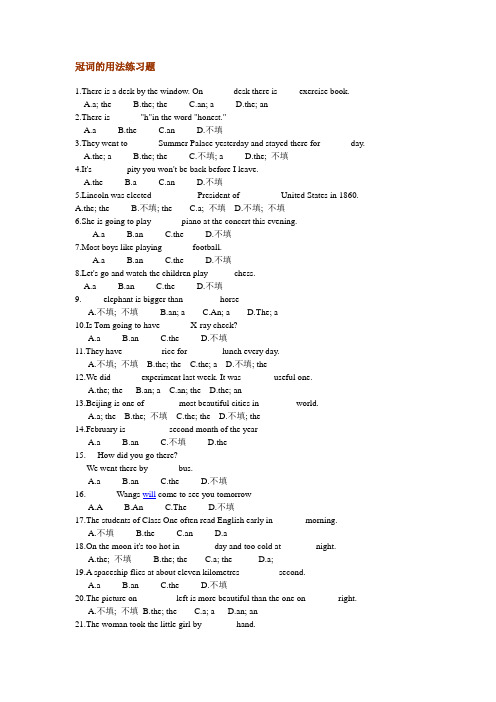
冠词的用法练习题1.There is a desk by the window. On_______desk there is_____exercise book.A.a; theB.the; theC.an; aD.the; an2.There is_______"h"in the word "honest."A.aB.theC.anD.不填3.They went to_______Summer Palace yesterday and stayed there for_______day.A.the; aB.the; theC.不填; aD.the; 不填4.It's________pity you won't be back before I leave.A.theB.aC.anD.不填5.Lincoln was elected__________ President of _________United States in 1860.A.the; theB.不填; theC.a; 不填D.不填; 不填6.She is going to play_______piano at the concert this evening.A.aB.anC.theD.不填7.Most boys like playing_______football.A.aB.anC.theD.不填8.Let's go and watch the children play______chess.A.aB.anC.theD.不填9._____elephant is bigger than________ horseA.不填; 不填B.an; aC.An; aD.The; a10.Is Tom going to have_______X-ray check?A.aB.anC.theD.不填11.They have_________rice for________lunch every day.A.不填; 不填B.the; theC.the; aD.不填; the12.We did_______experiment last week. It was _______useful one.A.the; theB.an; aC.an; theD.the; an13.Beijing is one of________most beautiful cities in ________world.A.a; theB.the; 不填C.the; theD.不填; the14.February is__________second month of the yearA.aB.anC.不填D.the15.----How did you go there?----We went there by_______bus.A.aB.anC.theD.不填16._______Wangs will come to see you tomorrowA.AB.AnC.TheD.不填17.The students of Class One often read English early in_______ morning.A.不填B.theC.anD.a18.On the moon it's too hot in________day and too cold at________night.A.the; 不填B.the; theC.a; theD.a;19.A spaceship flies at about eleven kilometres_________second.A.aB.anC.theD.不填20.The picture on_________left is more beautiful than the one on _______right.A.不填; 不填B.the; theC.a; aD.an; an21.The woman took the little girl by________hand.A.aB.anC.theD.不填22.Mr. Read patted him on________should er.A.aB.anC.theD.不填23.All the work had to be done by_______hand when there were no modern machines.A.不填B.theC.anD.a24.We should always think of________old and_______sick.A.the; theB.an; aC.不填; 不填D.the; a25.May I have _______look at the book?A.aB.anC.theD.不填26.It took me_______hour and______half to finish the work.A.a; aB.an; anC.a; anD.an; a27.She was in______hurry to work.A.不填B.aC.anD.the28.My brother has an interest in drawing_______horses.A.theB.anC.aD.不填29.Sam is_______man easy to get along with.A.不填B.theC.aD.an30.Europe and America are separated by_______ Atlantic Ocean.A.不填B.theC.aD.an31.The largest landmass is usually divided into two "continents" along______Ural Mountains.A.不填B.theC.aD.an32.There are only______few mistakes in your composition. Don't make______same ones again, please.A.a; theB.a; aC.the; theD.不填; 不填33.Henry is fond of playing________piano while Alice is interested in listening to _______ music.A.不填; .theB.the ; 不填C.the; theD.不填; 不填34.What________weather we are having today!A.aB.theC.不填D.an35.Tom met his old school friend on his way________home from China.A.aB.theC.不填D.an36.Spring is___best season of the year. Autumn is________busy season.A.a; aB.the; theC.a; theD.the; a37.Let's go and have_______walk around_________garden.A.a; theB.the; theC.a; aD.the; a38.Children usually go to________school at _______age of sixA.the; theB.a ; theC.不填; theD.a; a39.At last we got to________place where Chairman Mao had once lived.A.aB.anC.不填D.the40.Sam is________man to speak at the meeting tomorrow.A.不填B.theC.aD.an41.Birds can fly high in________sky.A.不填B.theC.aD.an42.Taiwan is_______island, it is_______largest island of China.A.a; theB.the; theC.an ; theD.an; a43.It is cold in________winter. And______days are shorter.A.不填; theB.the; theC.the; 不填D.a; the44.Were there is_______will there is______wayA.the; theB.a; aC.a; theD.the; a45.The workers in that factory are paid by________hour.A.aB.anC.theD.不填46.________Chinese are________hardworking people.A.The; theB.不填; aC.不填; 不填D.the; a47.He bought_______dictionary______last week.A.the; theB.a; 不填C.a; theD.the; a48.They always have_______breakfast in the factoryA.aB.anC.theD.不填49.Tom is_______8-year-old boy.A.aB.anC.theD.不填50.______sun rises in _______rest.。
小学冠词练习题及答案
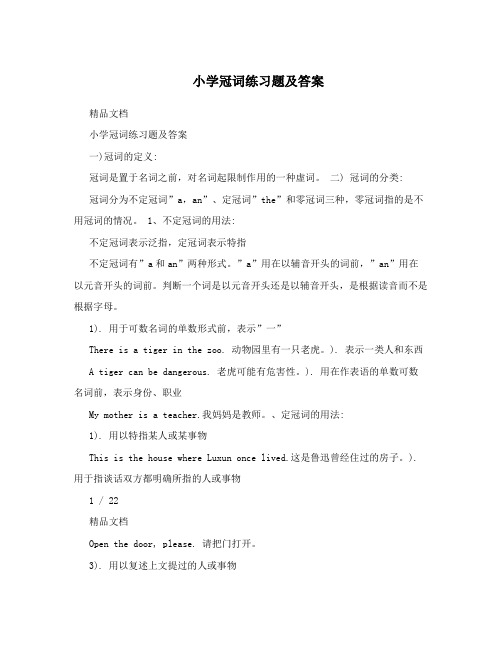
小学冠词练习题及答案精品文档小学冠词练习题及答案一)冠词的定义:冠词是置于名词之前,对名词起限制作用的一种虚词。
二) 冠词的分类: 冠词分为不定冠词”a,an”、定冠词”the”和零冠词三种,零冠词指的是不用冠词的情况。
1、不定冠词的用法:不定冠词表示泛指,定冠词表示特指不定冠词有”a和an”两种形式。
”a”用在以辅音开头的词前,”an”用在以元音开头的词前。
判断一个词是以元音开头还是以辅音开头,是根据读音而不是根据字母。
1). 用于可数名词的单数形式前,表示”一”There is a tiger in the zoo. 动物园里有一只老虎。
). 表示一类人和东西A tiger can be dangerous. 老虎可能有危害性。
). 用在作表语的单数可数名词前,表示身份、职业My mother is a teacher.我妈妈是教师。
、定冠词的用法:1). 用以特指某人或某事物This is the house where Luxun once lived.这是鲁迅曾经住过的房子。
). 用于指谈话双方都明确所指的人或事物1 / 22精品文档Open the door, please. 请把门打开。
3). 用以复述上文提过的人或事物Once there lived a lion in the forest. Every daythe lion asked small animals to look for food for him.从前森林里住着一只狮子。
每天这只狮子要小动物们为他寻找食物。
). 用在序数词和形容词最高级前January is the first month of the year. 一月份是一年当中的第一个月。
Shanghai is the biggest city inChina. 上海是中国最大的城市。
). 表示世界上宇宙中独一无二的事物the sun 太阳 the moon 月 the earth 地球 the sky 天空 the world 世界). 指由普通名词构成的专有名词the West Lake 西湖 the Great Wall 长城the United States 美国 the United Nations 联合国). 表示方向、方位in the east 在东方 in the west 在西方 in the front 在前面at the back 在后面 in the bottom 在底部 at the top 在顶部 on the right 在右边 on the left 在左边). 在海洋、江河、湖泊、山脉、海峡、海湾等地理名词前the Pacific Ocean 太平洋the Huanghe River 黄河2 / 22精品文档the Tainshan Mountains 天山山脉 the Taiwan Straits 台湾海峡9). 在姓氏复数前,表示一家人The Bakers came to see me yesterday. 贝克一家人昨天来看我。
定冠词和不定冠词的用法(含练习与答案)

定冠词和不定冠词的⽤法(含练习与答案)定冠词the的⽤法1.特指某⼈,某事。
(这,那;这些,那些)(1)Open the window,please!(2)The boy in a yellow shirt is my elder brother.穿黄⾊衬衫的那个男孩是我哥(3)The books on the desk are Lucy’s.课桌上的(那些书)是露西的.2.指上⽂已提到的⼈或事.(1)There is a map(泛指)of China,the map(特指) is on the wall.(2)Yesterday my parents took me to a zoo(泛指).In the zoo (特指)we saw an elephant(泛指),the elephant (特指)was from America.3.指世界上独⼀⽆⼆的事物.(the sun太阳;the moon⽉亮;the earth地球)(1)The s un\moon is shining照耀brightly灿烂地in the sky. (2)The sky 天空is blue.4.⽤在由普通名词构成的专有名词前.(1).the Great Wall.长城(2).the Summer Palace (3).the People’s Farm.⼈民农场(4).the Children’s Palace.少年宫5.⽤在序数词前和形容词最⾼级前.(1)He lives on the fifth floor. .(2)December is the twelfth month of a year.(3)You’re the youngest in your class.(4)The most important thing 最重要的事for us is to keep health.6.⽤在姓⽒复数前,表⽰夫妇俩或全家⼈.(1)The Green s work in the same factory.(2)The Blacks went to New York for a vacation last month.7.⽤在⽅位名词前,表⽰时间,地点.或⽤于习惯⽤语中.On the rignt\left;under the bed.;on the table.;behind the door.;In the end;at the same time;in theeast\west\south\north.*不⽤定冠词的情况.1.表⽰交通⼯具,学科名称前.by( bike\bus\taxi\train\plane\boat\subway);by sea.坐船;by air乘飞机;on foot.步⾏Have a Chinese上语⽂课;Have a math lesson上数学课2.节假⽇,星期,⽉份前.National Day;Teachers’ Day;;Women’s Day;on Monday\Tuesday;in September;3.在⼀⽇三餐,体育类,等名词前.(1)I cooked some noodles for supper/dinner.(2)The old man likes playing chess\playing (soccer\baseball).注意:演奏某种乐器,要加定冠词the.Play the (violin\guitar\erfu\pianol\trumpet\.music)at home.;at first⾸先;at last最终;at nignt\noon.;在晚上;at work在⼯作on time.准时;Be ill in bed卧病在床;be ill inhospital.⽣病住院;不定冠词A,AN的⽤法.1.表⽰泛指,或指某⼀类⼈或事(1)What’s this?It’s a pen. (2)This is a dictionary.(3)A boy is waiting for you.(4)A horse is a usefuf animal.马是有⽤的动物..4.⽤在某些固定词组中.A bit.;A little;A lot of;have a look at瞧⼀瞧;have a good\great time过的愉快;in a word.5.a⽤在以辅⾳⾳素开头的单词前.an⽤在与原⾳⾳素开头的单词前.An egg;an apple;an old man;an English book;an empty bottle.;an hour;(●Exercise(练习)⼀.1( )There is____apple tree in my garden. A.a B.an. C.the2( )Horse is____ useful animal. A.a. B.an. C.+3( )LiLy is____ 8-year-old girl. A.a . B.an. C.the.4( )There is____map of China,___map is on____wall.A.the. the .theB.a. the theC.a. a the.5( )Yesterday we had_______wonderful time at the park.A.a.B.+C.an6( )Would you please pass me_______ sugar on ___table?A.a .+B.an.aC.the,the7( )Go to the open air and enjoy____moon. A.the B.a. C.an8( )Tom likes playing______guitar,but he doesn’t like playing________chess.A.the theB.a aC.the. +9( )This is one of_________interesting books on you subjuject..B.the most.C.the most of10( )I bought some flowers for my mother on_______mothers’s day.A.theB.a.C.+11( )We can’t see____sun at____night. A.a the B.the an C.the +12( )________elephant has________ long nose A.an.a B.a an C.a the 13( )Tom missed the class because he was illin_______ hospital.A.theB.aC.+14( )My aunt works in_______hospital,she is______nurse. A.the.a B.a.the C.+.a.15( )Who is________man with glasses? A.the B.a. C.an ⼆.1( )__month of the year is August. A.The eighth. B.The eight.C.Eight2( )Jim’s father usually goes to work by___________ A.bus B.a bike C.a taxi3( )Maria likes having hamburgers and milk for____dinner. A.the. B.a. C.+4( )Tony usually goes to school_______his bike. A.in B.by. C.on.5( )September 10th is ______. A.the teacher’s Day. B.Teachers’ Day. C.Teacher’s Day.6( )Jack is having _______music lesson next Wednesday. A.a. B.the. C.an7( )Tony is________(of the three\of all in his class).A.tallerB.the taller.C.the tallest.8( )-By the way,have you got___e-mail address? A.a B.an C.the 9( )___woman in a red dress is a very popular teacher in our school.A.A.B.TheC.\10( )More and more foreign students come to China to learn__Chinese.A.aB.theC.\11( )Students often play___volleyball in___afternoon.A.\,anB.\,the12( )-what’s___date today?-It’s June 26th.A.a.B.an.C.the13( )Mike is___university student.He is ___honest boy.A.a,aB.an.anC.a,an14( )We always have___rice for___lunch. A.\.\ B.\.a C.the,the. Answers:⼀.1-5:BABBA; 6-10:CACBC; 11-15:CACAA;⼆.1-5:AACCC; 6-10:ACBBC; 11-14:BCCCA。
(完整)小学英语冠词练习题
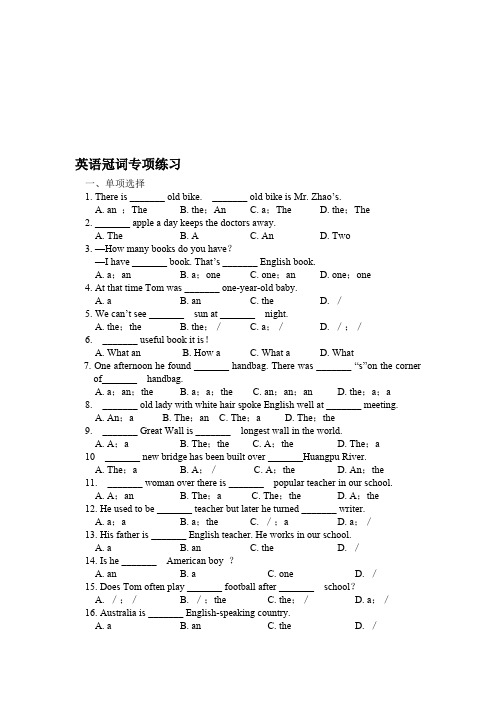
一、单项选择
A. an ;The
1. There is _______ old bike. _______ old bike is Mr. Zhao’s.
B. the;An
C. a;The
D. the;The
2. _______ apple a day keeps the doctors away.
A. a
B. an
C. the
D. /
hing at a time and All things in their being are good for somethin
17. She has _______ orange skirt. _______ skirt is nice.
A. a;The
D. What
7. One afternoon he found _______ handbag. There was _______ “s”on the corner
of_______ handbag.
A. a;an;the
B. a;a;the
C. an;an;an
D. the;a;a
8. _______ old lady with white hair spoke English well at _______ meeting.
A. a
B. an
C. the
D. /
25 The museum is quite far. It will take you half _______ hour to get there by
_______ bus.
A. an;/
B. an;a
C. a;/
D. /;/
英语冠词练习题及答案
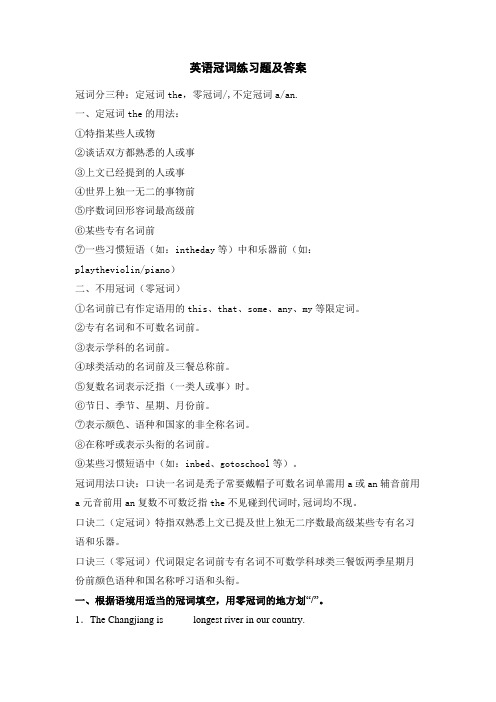
英语冠词练习题及答案冠词分三种:定冠词the,零冠词/,不定冠词a/an.一、定冠词the的用法:①特指某些人或物②谈话双方都熟悉的人或事③上文已经提到的人或事④世界上独一无二的事物前⑤序数词回形容词最高级前⑥某些专有名词前⑦一些习惯短语(如:intheday等)中和乐器前(如:playtheviolin/piano)二、不用冠词(零冠词)①名词前已有作定语用的this、that、some、any、my等限定词。
②专有名词和不可数名词前。
③表示学科的名词前。
④球类活动的名词前及三餐总称前。
⑤复数名词表示泛指(一类人或事)时。
⑥节日、季节、星期、月份前。
⑦表示颜色、语种和国家的非全称名词。
⑧在称呼或表示头衔的名词前。
⑨某些习惯短语中(如:inbed、gotoschool等)。
冠词用法口诀:口诀一名词是秃子常要戴帽子可数名词单需用a或an辅音前用a元音前用an复数不可数泛指the不见碰到代词时,冠词均不现。
口诀二(定冠词)特指双熟悉上文已提及世上独无二序数最高级某些专有名习语和乐器。
口诀三(零冠词)代词限定名词前专有名词不可数学科球类三餐饭两季星期月份前颜色语种和国名称呼习语和头衔。
一、根据语境用适当的冠词填空,用零冠词的地方划“/”。
1.The Changjiang is _____ longest river in our country.2.Here is a picture of a modern car factory. My father works in _____ factory. 3.______ girl in red is my sister.4.Can you see _____ sun in the sky?5.He used to be _____ engineer.6.Give me _____ pen, please.7.______ underground train can start and stop quickly.8._____ boy is waiting for me.9.A dictionary is _____ useful book.10.119 is _____ telephone number.11.There is ____ “R” in the word “red”.12.Her parents lived in a small far away village in _______ north.13.It's _______ dream come true for me.14.I have ________ uncle and he is a teacher.15.She has a pen. ________ pen is blue.16.Please don’t shout at her. She is only____eight-year-old girl.17.—Have you read a book called The Merchant of Venice?—Yes.___________book is very interesting.18.Qu Dongyu is ________ official(官员) of the United Nations, who is from Yongzhou.19.The boy went to school by_________, but there was a road accident. 20.—John and I will(将) go to the movie My People My Country (《我和我的祖国》)”—It's raining outside. You'd better(最好) take________ umbrella to the cinema. 21.It is unusual for an armless boy to play ___________ piano so well with his feet. 22.—Do you like ________ movie Sing?—Yes. I think it's ________ most interesting movie this year.23.My brother was good at playing ________ football when he was young. 24.After ________ quick lunch, Harry ran to school.25.—Who's ________ boy in black over there?—My cousin Mike. He is ________ friendly boy.26.It's ________ interesting story for all the children.27.________ Smiths are having ________ lunch now.28.My mum plays ________ piano very well.29.—Does John go to school by ________ bike?—No. He takes ________ bus.30.There is __________ picture of __________ elephant on __________ wall. 31.This is __________ useful book. I’ve read it for __________ hour.32.__________ elephant is much heavier than __________ horse.33.__________ doctor told him to take __________ medicine three times ______ day.34.Let’s go out for __________ walk.35.It’s too hot. Open __________ door, please.36.There is __________ woman over there, __________ woman is Meimei’s mother.37.__________ sun rises in __________ east.38.__________ Changjiang River is __________ longest river in __________ China.39.Are you going to do it __________ second time?【参考答案】1.The 2.The 3.The 4.The 5.An 6.A 7.An 8.A 9.a 10.a 11.An 12.The 13.A 14.An 15.The 16.An 17.The 18.An 19.bus/bike 20.An 21.the 22. the the 23./ 24.a 25. the a 26.An 27. The / 28.The 29. / a / the30. a an the 31. a an 32. An a 33. The the a 34.a 35.The 36. a the 37. The the38. The the × 39.a二、单选题1.Edward and William are brothers. There is ________ uncommon similarity between ________ two boys.A.an; / B.a; the C.an; the D.a; /2.— Do you go to school by________ train?— No. I take ________ subway.A./; the B.the;a C.a; the 3.It’s ________ useful book.A.an B.a C.the D.∕4.This is _______ eraser and ________ eraser is white.A.a; the B.an; an C.an; the5.Tina is from ________ European country and she is ________honest girl.A.an; a B.a; an C.the; an6.The magazine can’t be taken out of the reading room for _______ time being. A.a B.an C.the D./7.This is ________ African elephant. That’s ________ Asian tiger.A.a; a B.an; an C.an; a D.a; an 8.Students usually play _______ table tennis at school for an hour every day. A.a B.an C.the D.不填9.—Who is ________ girl playing chess over there?—Oh, she’s my friend. Her name’s Grace.A.a B./ C.the10.Do you know who wears ________ uniform at work?A.a B.an C.the D./11.Every day, my father plays ______ basketball for ______ hour.A./; an B.the; a C.a; a D./ ; the12.Miss White, I can play ________ guitar in the school show.A.a B.an C.the D./13.This is ________ useful course that is taught in ________ unusual way. We are all interested in it.A.a; a B.an; an C.a; an D.an; a14.Miss Liu is ________ interesting teacher and she teaches ________ English. A.an; our B.an; us C.a; our D.a; us15.People will float around in________ space because there is no gravity. A.the B.a C.an D./16.What ________ nice day! Let’s go for a picnic.A.the B.an C.a D./17.We should have ________ pity on wild animals because most of them are now in danger.A.an B.a C.the D./18.It’s ________ fine day today. Let’s g o out to go for a walk.A.a B.an C.the D./19.It is unhealthy to go to school without ________ breakfast.A.a B.an C.the D./20.—What’s this in English?—It’s ________ orange.A.a B.an C.the D.不填21.My brother usually _________ his classroom after school. But now he_________ soccer.A.cleans; plays B.cleaning; playingC.cleans; is playing D.clean; is playing the22.—What’s this?—It’s ________ eraser. ________ eraser is mine.A.an; A B.a; The C.the; An D.an; The 23.—Do you know ________ girl with long curly hair?—Yes, she is Mary. She plays ________ violin very well.A.a;/ B.the;/ C.the; the D.a; the 24.—Can you play ________ volleyball, Jack?—Sorry, it’s difficult. But I can play ________ violin. It’s easy for me . A.the;the B.the;/ C./;the D./;/25.— Y ou look tired. What’s the matter _______ you?—I have ______ very sore throat. I didn’t sleep well last night.A.to; a B.to; the C.with; a D.with; the 26.— Look! ________ English dictionary is on the desk.—Oh, ________ dictionary is Jack’s.A.An, a B.A, a C.An, the D.A, the 27.—It’s so hot in the room, just like in ________ oven.—You’re right. Let’s open ________ door to let the wind in.A.an; the B.the; an C./; the D.an; an28.This is ________ useful article on how to be ________ honest man.A.a, the B.an, the C.an, an D.a, an29.I like playing ________ chess but my brother likes playing ________ piano. A.the, the B.the, / C./, the D.a, the30.________ man with ________ iPhone X in his hand looks very modern. A.The; an B.The; the C.A; an D.A; the31.We should have _______ apple every day to keep healthy.A.a B.an C.the D./32.—I don't like either of the sweaters. Can I try on a __________one?—OK, wait a minute.A.second B.third C.fourth33.Ken is good at playing ________ badminton(羽毛球) and he can also play________ guitar.A.the; / B.the; the C.the; / D./; the34.Mr. Smith is ________ artist.A./ B.a C.an D.the35.________ excellent painting! Who drew it?A.How B.What an C.What a36.My little brother has never been to _______ amusement park.A.a B.an C./ D.such37.There is _______ elephant in the zoo, _______ elephant comes from Africa. A.the; the B.the; / C.an; the D.an; /38.— You missed ________ exciting football match.—It’s not ________ big deal. I don’t like football.A.a;a B.the;an C.an;a D.an;/ 39.There is ________ eraser in the lost and found box.A.the B.a C.an40.What ________ sad news! We can’t get the movie tickets.A./ B.an C.a41.—Tina, what’s ________ matter with you?—I have ________ fever.A./; a B.the; a C./; /42._______ woman over there is _______ popular teacher in our school.A.A; / B.The; a C.The; / D.A; the 43.Here’s ________ uniform on the desk. ________ uniform is Alice’s. A.a, The B.an, The C./, An D.a, An44.I have _________ egg and _________ milk every morning.A.an; / B.a; a C.a; /45.It is difficult for Gina ________.A.to play violin B.play the guitar C.to play the drums D.play baseball 46.— What time is ________ school over?— At five ten.A.\ B.the C.our47.They have ________ school trip and ________ English party this month. A.a; a B.a; an C.an; an D.an; a 48.There is ________ elephant in the zoo. ________ elephant is from Africa. A.an; The B.the; An C.an; An D.a; The49.My brother likes playing ________ soccer but he doesn’t like playing________ drums.A.the; / B.the; the C./; the D./; /50.— Where are the boys?— They ________ soccer at school.A.are playing B.are playing theC.play D.play the51.The little girl began to play ________ violin at the age of five.A.a B.the C./52.— Jenny, do Chinese people celebrate ________ Easter Day?—No. This is the first time I’ve celebrated ________ festival.A.the; the B.the; a C./; the D./; a53.— Who is ________ inventor of the radio?— Guglielmo Marconi.A.a B.an C.the54.Sam wants to learn how to play _______ guitar, so he asks his mom to buy _______.A.the; it B.the; one C.a; it55.Gina has ________ English story book, ________ book is very interesting. A.a; the B.the; the C.an; the D.an; a56.— How do you like your new English teacher, Bill?—He’s great. And he’s a man with _________ magic voice.A.a B.an C.the D./57.—Ms. Li, listen! ________ beautiful song it is! Can you teach us? —Certainly.A.How B.What C.What a D.What an 58.Lucy is ________ guide, and last summer she showed me around ________ Canada.A.a; the B.a; 不填C.不填; the D.不填; 不填59.Millie likes playing ________ guitar, but she doesn’t like playing________ basketball.A.the, the B.the, / C./, /60.Cindy’s father has _________ axe and often uses it to cut down trees. A./ B.a C.an D.the 61.Shanghai is ________ interesting city with a lot of department stores and huge shopping centres.A.a B.an C.the D./62.—Is SCAR a robot or a dog?—It’s robot dog with four legs. It can do dangerous work for people.A./ B.a C.an D.the63.Wang Yuan can play ________ violin, but she can’t play ________ chess. A.the; the B./; the C.the; / D./; /64.— Would you please give me ________ clean spoon?—Wait a minute. I’ll go and get one for you.A.a B.an C.the D./65.Perhaps there will be no water or air on _________ Earth.A.a B.an C.the D./66.—Have you ever seen ________ new movie, Hello, Li Huanying?—Yes, and Jia Ling is my favorite actress.A.a B.the C.an67.He’s ________ good English teacher and all the students like him very much. A.an B.a C.the D./68.________ July 23, People all over our country will warmly celebrate________ anniversary (周年) of the founding of the Communist Party of China (中国共产党).A.In; 100th B.On;100th C.On; the 100th D.In; the 100th 69.—What do you want to be in ________ future, Carla?—I want to be ________ excellent volleyball player like Lang Ping.A.the; an B./; a C.the; the D./; /70.Jill Biden, ________ 78-year-old man, was chosen ________ President of the US last year.A.a; a B.a; / C.the; a D.the; the71.This is ________ one-way street, you are only ________ 8-year-old child, you can’t ride a bike alone here.A.an; an B.an; a C.a; an D.a; a72.Uncle George will go to ________ Japan for ________ important meeting next month.A.the; a B.the; an C./; a D./; an73.Susan can play the _________ well.A.chess B.violin C.tennis D.basketball74.A drop of water travelled a long way and ran into ________ Huangpu River. A.a B.an C.the D./75.We stayed at ________ very nice hotel, but I can’t remember ________ name. A.a, a B.the, the C.a, the D.the, a76.My brother’s dream is to be ________ doctor in the future.A.a B.an C.the D./77.Her mother works at ________ university.A.a B.an C.\78.Would you please watch the CCTV program, The Reader, with me on ________ Saturday night, Maria?A.a B.an C.the D./79.—What do you think about ________ story of Yu Gong?—I think it’s really interesting.A.a B.an C.the D./80.—Kitty, what do you think of ________ film The Battle at Lake Changjin (《长津湖》)?—Pretty good. I’ve never seen ________ better one.A.a; a B.the; / C.a; the D.the; a81.— Do you know _______ young man living next door?— Sure, he is very kind and always supports kids in poor areas.A.a B.an C.the D./82.Ai Qing, a Chinese poet, has written ________ poem called I Love This Land. In this poem, he shows his love to the country.A.a B.an C.the D.83.—Canada is ________ European country, right?—No, it’s in North America.A.a B.an C.the D./84.—Mum, I’m making some plans to volunteer at ________ animal hospitalthis summer.— That sounds interesting.A.a B.an C.the D./85.—Do you often play ________ tennis after school?—No, I don’t like sports. I often play ________ guitar.A.a,the B.the,/ C./,the86.—Mum, could we buy _________ new tent for the camping trip?—Sure. Let’s go to the supermarket this afternoon.A.a B.an C.the D./87.—What do you think of ________ dish-washing machine you bought several days ago?—It turns out to be very useful. It helps save lots of my time.A.a B.an C.the D./88.Zhang Wenhong’s sense of humor has made it ________ for the knowledge to reach ________ public.A.more easily; / B.more easily; the C.easier; / D.easier; the 89.—How about ________ speech on chemistry?—I should say it was ________ great success.A./; the B.a; the C.the; a D.the; /90.Look over there. ________ tall boy with short, black hair can play ________ drum very well.A.The, / B.The, the C.A, / D.The, a【参考答案】二、单选题1.C解析:C【解析】【分析】【详解】句意:爱德华和威廉是兄弟。
小学英语语法——冠词知识点讲解+练习
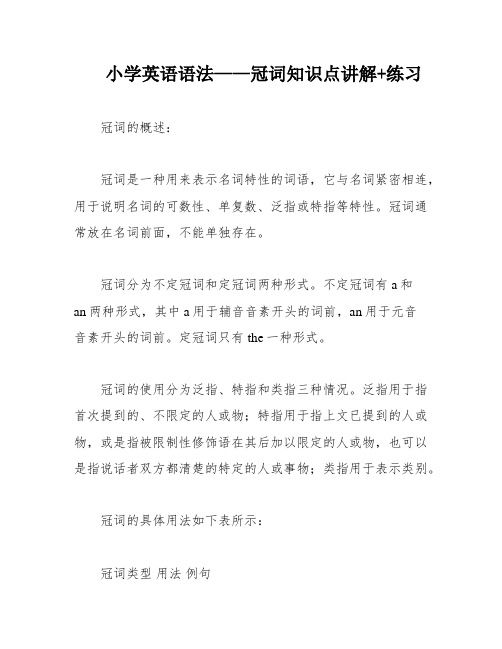
小学英语语法——冠词知识点讲解+练习冠词的概述:冠词是一种用来表示名词特性的词语,它与名词紧密相连,用于说明名词的可数性、单复数、泛指或特指等特性。
冠词通常放在名词前面,不能单独存在。
冠词分为不定冠词和定冠词两种形式。
不定冠词有a和an两种形式,其中a用于辅音音素开头的词前,an用于元音音素开头的词前。
定冠词只有the一种形式。
冠词的使用分为泛指、特指和类指三种情况。
泛指用于指首次提到的、不限定的人或物;特指用于指上文已提到的人或物,或是指被限制性修饰语在其后加以限定的人或物,也可以是指说话者双方都清楚的特定的人或事物;类指用于表示类别。
冠词的具体用法如下表所示:冠词类型用法例句不定冠词泛指单一、每一、任一事物 a(n) A book is on the table。
类指类别 A XXX can fly。
定冠词上文提到过的人或事物 The boy is in the classroom。
特指被限制性修饰语所限定的人或事物 XXX。
说话双方都清楚的人或事物 XXX。
世上独一无二的事物 XXX。
类指类别 XXX。
零冠词名词前泛指人或事物 Cats are cute。
类指类别 XXX。
冠词考点纵览:冠词的考点主要包括不定冠词a/an的用法、泛指和特指的区别、类指的使用等。
具体例题如下:考点一:不定冠词a/an的用法1) This is a book。
这是一本书。
2) There is a boy in the classroom。
教室里有一个男孩。
3) That XXX。
那是一个书包。
考点二:泛指人或事物的某一类别,以区别于其他种类。
1) A plane is a machine that can fly。
飞机是一种能飞的机器。
2) A tiger XXX 老虎可能会很危险。
3) A horse is XXX。
马对人类有用。
考点三:泛指某人或某物。
1) A girl is waiting for you。
小学英语冠词练习题
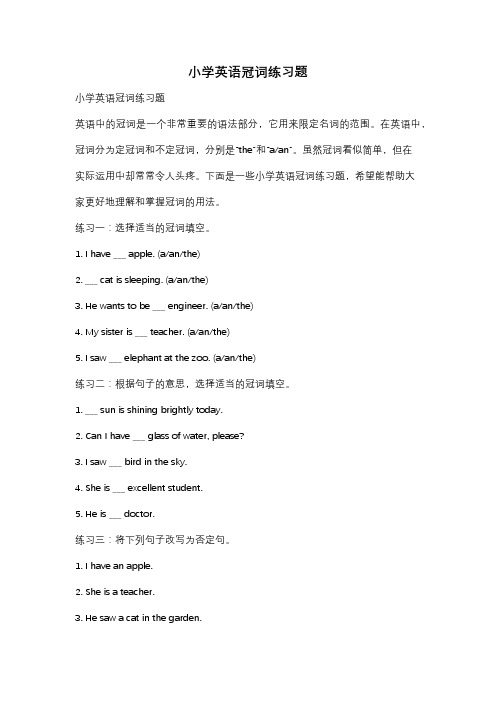
小学英语冠词练习题小学英语冠词练习题英语中的冠词是一个非常重要的语法部分,它用来限定名词的范围。
在英语中,冠词分为定冠词和不定冠词,分别是“the”和“a/an”。
虽然冠词看似简单,但在实际运用中却常常令人头疼。
下面是一些小学英语冠词练习题,希望能帮助大家更好地理解和掌握冠词的用法。
练习一:选择适当的冠词填空。
1. I have ___ apple. (a/an/the)2. ___ cat is sleeping. (a/an/the)3. He wants to be ___ engineer. (a/an/the)4. My sister is ___ teacher. (a/an/the)5. I saw ___ elephant at the zoo. (a/an/the)练习二:根据句子的意思,选择适当的冠词填空。
1. ___ sun is shining brightly today.2. Can I have ___ glass of water, please?3. I saw ___ bird in the sky.4. She is ___ excellent student.5. He is ___ doctor.练习三:将下列句子改写为否定句。
1. I have an apple.2. She is a teacher.3. He saw a cat in the garden.4. They are engineers.5. We saw an elephant at the zoo.练习四:将下列句子改写为一般疑问句,并作出回答。
1. She is a doctor.2. He has a dog.3. They saw an elephant at the zoo.4. We are students.5. I have an apple.练习五:将下列句子改写为选择疑问句,并作出回答。
冠词与介词的用法讲解及练习

冠词与介词的用法讲解及练习(小学)一、冠词分类及其用法1.冠词的分类不定冠词:a 和an冠词定冠词:the零冠词:不使用冠词2.不定冠词的用法(1)a用在以辅音音素开头的单词前. A useful bookan用在以元音音素开头的单词前.An egg(2)基本用法:指人或事物的某一种类e.g. She is a girl. 她是女孩.This is a desk. 这是一张书桌.(3)泛指某人或者某物,但又不具体说明何人何物.e.g. I can see a kite. 我能看见一只风筝.A boy is in Grade 1. 一个男孩在一年级(4)表示“数量”,“有一”“每一”的意思.e.g. We have six classes a day. 我们一天上六节课.(5)表示“同一”,相当于the samee.g The two boys are of ______ age.Cotton of ______ kind was stored together.(6)用于某些物质名词或抽象名词前,表示“一种、一类、一份、一场、一阵”.e.g That is ____ green tea.They were caught in _____ heavy rain.a pleasure / a success/ a failure(7)用于专有名词前表示类似的一个或某一个.e.g ________ Mr. Li is asking to see you at the school gate.(8)否定比较级表达最高级意义时,常用借助于不定冠词a/ an. a/ an+比较级e.g. --- --What do you think of the film?----- Oh, I’ve never seen a worse one.----- How do you like Tom?------ I’m afraid that no one in my class has a cleverer brain than he.2.定冠词的用法(1)基本用法:“特指”.特指某(些)人或者某(些)事物,以便与其他的人或物有所区别.e.g. The book on the desk is Jim’s. 书桌上的那本书是吉姆的.The chairs are there. 椅子在那里.(2)指谈话双方都知道的人或事物.e.g. Where is the kite? 风筝在哪儿?(双方都知道指的是哪只风筝.)Open the door, please.请把门打开.(双方都知道要打开哪扇门.)(3)在叙述中,上文提到过的人或者事物,再次出现时.e.g. A:I can see a kite. 我看见一只风筝.B:where is the kite? 这个风筝在那里?(4)用在姓氏的复数名词前,表示“一家人”e.g. the Blacks 布来克一家(5)用在宇宙间独一无二的天体名词之前.e.g. the sun the sky the moon the earth(6)用在序数词和形容词最高级,及形容词only, very, same 前.e.g. I live on the second floor. 我住在二楼Skating is the best sport in winter. 滑冰是冬天最好的运动(7)用在某些建筑物和旅馆的名称之前.The Palace Museum The Summer Palace(8)用在表示乐器的名词之前.e.g. the violin the piano(9)用在一些习惯用语中e.g. in the dayin the morning / afternoon/ eveningthe day before tomorrow/ yesterdaythe next morning / week/ month/ yearin the sky/ water/ field/ countryin the darkin the rainin the distancein the middle (of)in the endon the wholeby the waygo to the theatre (cinema)3.零冠词的用法(1)名词前有了物主代词、指示代词、不定代词和“S”所有格时。
小学英语“冠词”用法整理,太齐全了(附练习)

小学英语“冠词”用法整理,太齐全了(附练习)冠词概述冠词是虚词,本身不能单独使用,也没有词义,它用在名词的前面,帮助指明名词的含义。
冠词分为不定冠词和定冠词两种。
不定冠词仅用在单数可数名词前面,表示“一”的意义,但不强调数目观念,只表示名词为不特定者。
定冠词则表示名词为特定者,表示“这”,“那”,“这些”,“那些”的意思,在可数的单复数名词或不可数名词前面都可以用。
a和an的区别不定冠词有a和an两种形式,a用于辅音(不是辅音字母)开头的词前,an用于元音(不是元音字母)开头的词前。
例如:a boy,a university,a european country;an hour,an honour,an island,an elephant,an umbrella不定冠词的用法1.泛指某一类人、事或物;相当于any,这是不定冠词a/an的基本用法。
2.泛指某人或某物,但不具体说明何人或何物。
3.表示数量,有“一”的意思,但数的概念没有one强烈。
4.表示“每一”,相当于every.例如,i go to school five days a week.我一周上五天课。
5.用在序数词前,表示“又一”,“再一”。
例如,i have three books.i want to buy a fourth one.我已经有三本书,我想买第四本。
6.用在某些固定词组中:a lot(of)许多,大量;after a while过一会儿定冠词的用法1.特指某(些)人或某(些)物,这是定冠词的基本用法。
2.指谈话双方都知道的人或事物。
例如:open the window,please.请打开窗户。
3.指上文已经提到的人或事物。
例如:i have a car.the car is red.我有一辆小汽车,它是红色的。
4.指世界上独一无二的事物。
例如:which is bigger,the sun or the earth?哪一个大,太阳还是地球?5.用在序数词,形容词最高级前。
18小学定冠词和不定冠词练习题
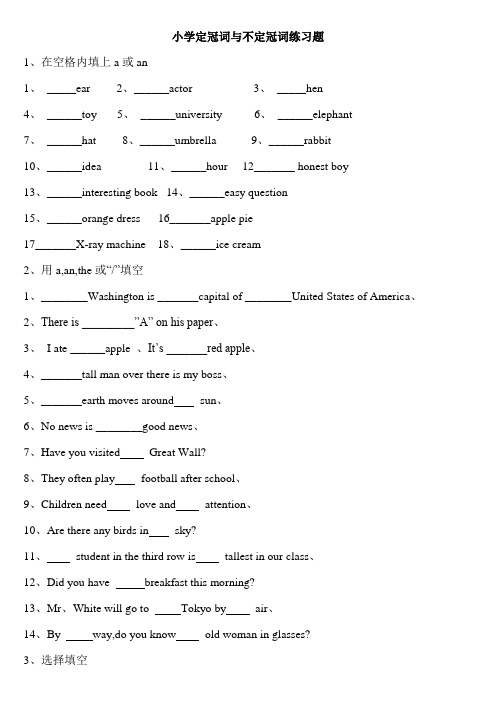
小学定冠词与不定冠词练习题1、在空格内填上a或an1、_____ear2、______actor3、_____hen4、______toy5、______university6、______elephant7、______hat 8、______umbrella 9、______rabbit10、______idea 11、______hour 12_______ honest boy13、______interesting book 14、______easy question15、______orange dress 16_______apple pie17_______X-ray machine 18、______ice cream2、用a,an,the或“/”填空1、________Washington is _______capital of ________United States of America、2、There is _________”A” on his paper、3、I ate ______apple 、It’s _______red apple、4、_______tall man over there is my boss、5、_______earth moves around sun、6、No news is ________good news、7、Have you visited Great Wall?8、They often play football after school、9、Children need love and attention、10、Are there any birds in sky?11、student in the third row is tallest in our class、12、Did you have breakfast this morning?13、Mr、White will go to Tokyo by air、14、By way,do you know old woman in glasses?3、选择填空1、Mom tells her little daughter old story every night、A、aB、/C、anD、the2、computer on the table is Susan’s、A、AB、AnC、TheD、/3、There is map of the world on wall、 map is mine、A、a, a, AB、a, the, TheC、the, the, TheD、the, the, A4、Whites live on floor、A、/, threeB、A, thirdC、The, thirdD、The, the third5、Spring comes after winter、A、/, /B、The, /C、The, theD、A, the6、I bought shoes yesterday、 shoes are very beautiful、A、a, TheB、a pair of, TheC、the, TheD、a pair, The pair7、He was soldier in the Second World War、A、aB、anC、theD、/8、She can play and 、A、the tennis, the guitarB、tennis, guitarC、the tennis, guitarD、tennis, the guitar9、I can see moon and clouds in the sky、A、the, aB、a, aC、the, /D、the, the10、“c” is in “cat、”“s” is in “sat、”A、An, AnB、An, AC、A, AD、A, An11. Tian’anmen Square is in Beijing、A、/, /B、A, /C、The, /D、/, the12、—Can you tell me nearest bookshop?—Go straight and turn right at_______third crossing, and you will see it、A、the, aB、the, theC、a, theD、the, /随堂监测A组I. 在下列句子的空格中填上适当的冠词,不需要的地方用“/”表示:1、This is ______ old map、It is ______ useful map、2、We have no classes in ______ afternoon on _______ Saturday、3、______ spaceship flies at about eleven kilometers _______second、4、Beijing is ______ capital of ______ China、It is _______ beautiful city、5、Roman was not built in ______ day、6、Chinese is quite ______ difficult language for Mike、7、Many ______ students will take ______ active part in sports meet、8、There is ______ interesting picture on ______ wall、9、Jenny found ______ wallet lying on ______ground、______ wallet was Mr、Black’s、10、Which is ______ biggest, ______ sun, ______ moon, or ______ earth?11、--- Which picture is more beautiful? --- ______one on ______ left, I think、12、--- Which is _____ way to ______ hospital?--- Go down this road and turn left on ______ second crossing、13、_______ more, _______ better、14、_______ Turners are sitting at breakfast table、15、Joe Hill was _______ fighter for ______ working class、16、When was ______ People’s Republic of China founded?17、In China ______ first English textbooks were published in _____late nineteenth century、18、After ______ breakfast he went to ______ school on ______ foot、19、______ Huanghe River lies in ______ north of China、20、He likes playing ______ football、His sister likes playing ______ piano、II、单项选择:1、上学A、go to schoolB、go to the schoolC、go to a school2、住院A, in the hospital B、in a hospital C、in hospital3、此刻A、at the momentB、at a momentC、at moment4、在课堂上A、in classB、in a classC、in the class5、在地球上A、on earthB、on an earthC、on the earth6、步行A、on footB、on the footC、on feet7、吃饭A、at a tableB、at the tableC、at table8、乘公共汽车A、take busB、by busC、by the bus9、在家A、at the homeB、at a homeC、at home10、在工作A、at workB、at the workC、at works11、跳高A、jump highB、high jumpC、the high jump12、坐飞机A、by airB、by the airC、on air13、乘火车A、by the trainB、by trainC、on train14、在校学习A、in the schoolB、in schoolC、in schools15、睡觉A、go to bedB、go to the bedC、go to a bed16、感冒A、have a coldB、have the coldC、have cold17、乘船A、by shipB、on shipC、by a ship18、玩得痛快A、have good timesB、have a good timeC、have good times19、事实上A、in the factB、in factsC、in fact21、从早到晚A、from morning to the eveningB、from morning to eveningC、from a morning to an evening随堂监测B组选择填空1、There is ______ old woman in the car、A、/B、theC、aD、an2、Shanghai is in _______ east of China、A、/B、anC、theD、a3、Bill is ______ English teacher、He likes playing ______ football、A、a, theB、an, theC、a, /D、/, /4、The museum is quite far、It will take you half _____ hour to go there by ______ bus、A、an, /B、an, aC、a, /D、/, /5、The story is ______ interesting、That means it is ______ interesting story、A、an, theB、the, a、C、/, anD、/, a6、Let’s go for ______ walk, shall we?A、aB、anC、theD、/7、This is ______ interesting story-book and it is also ______ useful one、A、a, aB、an, anC、an, aD、a, an8、_______ woman over there is ______ popular teacher in our school、A、A, anB、The, aC、The , theD、A, the9、They passed our school ______ day before yesterday、A、anB、oneC、aD、the10、Australia is ______ English-speaking country、A、aB、anC、theD、/11、Don’t play ______ basketball here、It’s dangerous、A、aB、anC、/D、the12、This is ______ apple、It’s _______ big apple、A、an, aB、a, theC、a, anD、an, the13、--- Have you seen ______ bag? I left it here just now、--- Is it ______ one on the chair near the door?A、a, aB、the, theC、a, theD、the, a14、I have ______ blue coat、A、aB、anC、theD、some15、This is _____ orange、_______ orange is on the table、A、a, TheB、an, TheC、an, AnD、the, An16、Have you had ______ breakfast?A、aB、anC、theD、/17、He wondered when the doctor could finish _____ operation、A、a B、an C、the D、any18、After ______ supper, he stayed at home and played ______ violin、A、the, theB、/, theC、/, aD、/, /19、There is ______ apple on the plate、A、aB、anC、theD、/20、He said that he got ______ “ C” in the test、A、aB、anC、theD、/21、______ new bridge has been built over ______ Huangpu River、A、The, aB、A, /C、A, theD、An, an22、English is _______ useful language in ______ world、A、an, theB、a, theC、the, theD、an, an23、In the word “ cariage” _______ “ r” is lost、A、theB、anC、aD、/24、With the help of his teacher he studied hard and got ______ “ A” in the test、A、aB、anC、theD、one25、I have two dogs、______ black one is two years old and ______ yellow one is three years old、A、A, aB、The, aC、The, theD、A、the26、Li Dan can play ______ piano very well、A、/B、aC、anD、the27、What ______ interesting film it is! I like ______ film very much、A、a, theB、a, aC、an, theD、The, /28、______ tall man over there is our ______ English teacher、A、A, theB、The, aC、A, anD、The, /小学英语冠词的用法提高专题精讲及同步练习冠词虽小,只有a,an与the三个,但却就是历年各地考试必考语言点之一。
(完整版)冠词练习题及答案
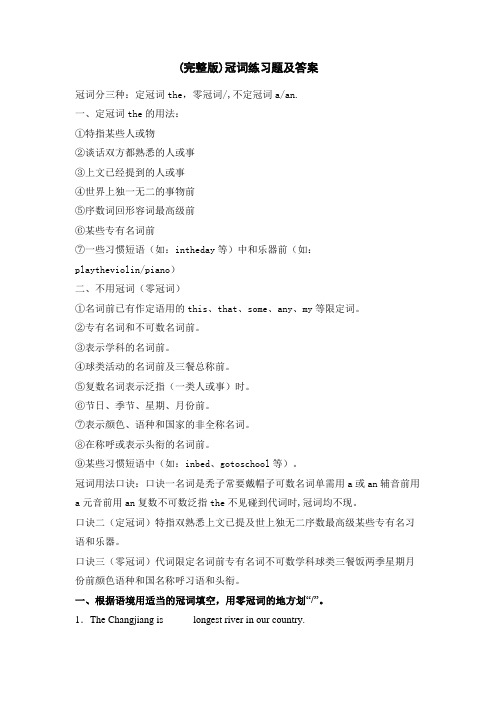
(完整版)冠词练习题及答案冠词分三种:定冠词the,零冠词/,不定冠词a/an.一、定冠词the的用法:①特指某些人或物②谈话双方都熟悉的人或事③上文已经提到的人或事④世界上独一无二的事物前⑤序数词回形容词最高级前⑥某些专有名词前⑦一些习惯短语(如:intheday等)中和乐器前(如:playtheviolin/piano)二、不用冠词(零冠词)①名词前已有作定语用的this、that、some、any、my等限定词。
②专有名词和不可数名词前。
③表示学科的名词前。
④球类活动的名词前及三餐总称前。
⑤复数名词表示泛指(一类人或事)时。
⑥节日、季节、星期、月份前。
⑦表示颜色、语种和国家的非全称名词。
⑧在称呼或表示头衔的名词前。
⑨某些习惯短语中(如:inbed、gotoschool等)。
冠词用法口诀:口诀一名词是秃子常要戴帽子可数名词单需用a或an辅音前用a元音前用an复数不可数泛指the不见碰到代词时,冠词均不现。
口诀二(定冠词)特指双熟悉上文已提及世上独无二序数最高级某些专有名习语和乐器。
口诀三(零冠词)代词限定名词前专有名词不可数学科球类三餐饭两季星期月份前颜色语种和国名称呼习语和头衔。
一、根据语境用适当的冠词填空,用零冠词的地方划“/”。
1.The Changjiang is _____ longest river in our country.2.Here is a picture of a modern car factory. My father works in _____ factory. 3.______ girl in red is my sister.4.Can you see _____ sun in the sky?5.He used to be _____ engineer.6.Give me _____ pen, please.7.______ underground train can start and stop quickly.8._____ boy is waiting for me.9.A dictionary is _____ useful book.10.119 is _____ telephone number.11.There is ____ “R” in the word “red”.12.Her parents lived in a small far away village in _______ north.13.It's _______ dream come true for me.14.I have ________ uncle and he is a teacher.15.She has a pen. ________ pen is blue.16.Please don’t shout at her. She is only____eight-year-old girl.17.—Have you read a book called The Merchant of Venice?—Yes.___________book is very interesting.18.Qu Dongyu is ________ official(官员) of the United Nations, who is from Yongzhou.19.The boy went to school by_________, but there was a road accident. 20.—John and I will(将) go to the movie My People My Country (《我和我的祖国》)”—It's raining outside. You'd better(最好) take________ umbrella to the cinema. 21.It is unusual for an armless boy to play ___________ piano so well with his feet. 22.—Do you like ________ movie Sing?—Yes. I think it's ________ most interesting movie this year.23.My brother was good at playing ________ football when he was young. 24.After ________ quick lunch, Harry ran to school.25.—Who's ________ boy in black over there?—My cousin Mike. He is ________ friendly boy.26.It's ________ interesting story for all the children.27.________ Smiths are having ________ lunch now.28.My mum plays ________ piano very well.29.—Does John go to school by ________ bike?—No. He takes ________ bus.30.There is __________ picture of __________ elephant on __________ wall. 31.This is __________ useful book. I’ve read it for __________ hour.32.__________ elephant is much heavier than __________ horse.33.__________ doctor told him to take __________ medicine three times ______ day.34.Let’s go out for __________ walk.35.It’s too hot. Open __________ door, please.36.There is __________ woman over there, __________ woman is Meimei’s mother.37.__________ sun rises in __________ east.38.__________ Changjiang River is __________ longest river in __________ China.39.Are you going to do it __________ second time?【参考答案】1.The 2.The 3.The 4.The 5.An 6.A 7.An 8.A 9.a 10.a 11.An 12.The 13.A 14.An 15.The 16.An 17.The 18.An 19.bus/bike 20.An 21.the 22. the the 23./ 24.a 25. the a 26.An 27. The / 28.The 29. / a / the30. a an the 31. a an 32. An a 33. The the a 34.a 35.The 36. a the 37. The the38. The the × 39.a二、单选题1.That woman is a doctor. She wears ________ uniform at work.A.a B.an C.the D./2.Steven thinks English is _______ useful subject. He reads English for_______ hour every morning.A.a; a B.an; a C.a; an D.an; an3.English is ________ useful language, so we should learn it well.A.an B.a C.the D./4.— Did you enjoy your stay in Beijing, Mrs Black?—Yes. I’ve had________ wonderful time.A.a B.an C.the5.—Have you ever seen the movie My country, My parents (我和我的父辈)?—Yes. ________ interesting and educational movie it is!A.What B.What an C.How D.What a6.—Do you know ________ tall man in ________ front of the school gate?—Sorry, I don’t know.A.a; / B.an; the C.the; / D.a; the7.It’s ________ important rule to wear school uniforms every day in our school.A.a B.an C./8.—How do people around ________ world celebrate (庆祝) their birthdays?—Oh, ________ answer would be different in different countries.A.a; a B.a; the C.the; a D.the; the9.Which of the following is RIGHT?A.All three systems remain for use now. B.She doesn’t dare go out alone at night.C.They were made to work long hours. D.The number of the students are fifty. 10.He sometimes goes to ________ movies ________ weekends.A./, on B./, at C.the, at D.the, in11.He asked whether June is _______ good time to visit Chongqing.A.a B.an C.the D./12.As ________ result of the heavy fog, all the flights were delayed yesterday. A.a B.an C.the D./13.Taiwan is ________ island and it is ________ biggest island in China. It is ________ nice place to go.A.the, the, a B.an, the, a C.a, a, the D.an, a, a14.In Xinhua Middle School, students in Grade 7 ________ 4 classes in the morning and ________ class finishes at 11:20.A.have, four B.has, fourth C.have, the fourth D.has, a fourth 15.There is ________ “h” in the word “hour”.A.a B.an C.the D./16.That’s my uncle. He’s ________ English teacher.A.a B.an C.the D./17.Boys and girls, after finishing ________ exam paper that may bring lots of confidence to you, you are sure to face any challenge with courage.A.a B.an C.the18.He wanted to be ________ engineer when he was young, but now he teaches in ________ university.A.an; an B.a; an C.an; a D.a; a19.Tom went up the stairs so fast-two at ________ time, but he was still late for the meeting.A.a B.an C.the D./20.May Day is ________ happy holiday. We usually take ________ vacation in a different part of the country.A.a; a B.the; the C./; / D.an; the21.My brother usually _________ his classroom after school. But now he_________ soccer.A.cleans; plays B.cleaning; playingC.cleans; is playing D.clean; is playing the22.I think soccer is ________ easy and relaxing sport.A.a B.an C./ D.the23.She is ________ university student and she likes playing ________ guitar. A.a; / B.a; an C.a; the D.an; /24.—It’s so hot in the room, just like in ________ oven.—You’re right. Let’s open ________ door to let the wind in.A.an; the B.the; an C./; the D.an; an25.—Do you want to watch ________ movie with me?—Yes, we can go to ________ one on Long Street.A.a; the B.an; the C.a; a D.an; a26.— Anna, what kind of movie would you like to watch tonight?—I’d like to watch ________ action movie.A.a B.an C.the D./27.—Let’s play ________chess now.—That’s boring. How about playing ________guitar?A.the; the B.the; / C./; the D./; /28.Look! This is ________ tiger and that is ________ elephant.A.an; a B.a; an C.a; the D.an; the 29.—Excuse me, John. What’s this in English?—It’s ________ cup.A.a B.an C.the D.\30.—Why did you laugh just now?—Ted wanted to tell us ________ very funny story, but he forgot ________ end himself.A./; the B.a; an C.a; the31.—Do you like playing ________ violin?—No, I like surfing ________ Internet.A.the; / B.a; the C./; the D.the; the 32.Once upon _______ time, there was ________ honest man living in a forest. A.a ; an B.an ; a C.the ; a D.a ; the 33.Tom didn’t play________ football, he played ________ piano for an hour. A.the; the. B./ ; / C./; the D.the; / 34.Mr. Smith is ________ artist.A./ B.a C.an D.the35.This is ________ African elephant. That’s ________ Asian tiger.A.a; a B.an; an C.an; a D.a; an36.My mother has _______ curly hair.A.a B.an C.the D./37.— Do you believe what he said?— Yes. He is ________ honest boy and he always tells ________ truth.A.a; a B.an; a C.an; the D.the; the 38._______ woman over there is _______ popular teacher in our school. A.A; / B.The; a C.The; / D.A; the 39.—Help me, doctor! I hurt my leg.—Don’t worry, dear. You ________ get ________ X-ray first.A.can, a B.should, an C.should, a40.Lao She is ________ unusual writer and he wrote a famous book called Tea House.A.an B.a C.the D.any41.I would like to be ________ teacher when I grow up.A.a B.an C.the D./ 42.—What’s the most important tradition in Chinese family?—I think it’s to respect ________ old and love ________ young.A.an; the B.an; a C.the; the43.Ben was ________ unusual man with great business talents, and he started his own business at the age of 20.A.a B.an C.the44.There is _________ “n”and ________ “s”in the word “nose”A.an; a B.an; an C.a; an45.—Mary, who is ________ boy over there?—He’s my cousin, ________ 18-year-old who feels good about himself.A.a; the B.the; an C.the; a46.There is ________ “s” and ________ “i” in the word “suit”.A.a; an B.a; a C.an; an47.Ms. Gao gave me ________ apple after lunch yesterday.A.a B.an C.the D./48.I have ________ egg and a glass of milk for ________ breakfast every day. A.an; / B.a; / C.an; the D.a; the 49.According to ________ local people, Ayers Rock is ________ special and magical place.A.a; the B.an; the C.the; a D.the; an50.________ old man behind Mary is ________ university teacher.A.An; an B.The; a C.The; an51.I can play ________ chess. I want to join ________ chess club.A.the; the B.the; a C./; the D.the; / 52.Jason used to be ________ university student. But now he is working for ________ African company.A.a; a B.a; an C.an; an D.an; a 53.—What is your brother doing?—He is playing soccer.A.a B.the C./ D.an54.— Where are the boys?— They ________ soccer at school.A.are playing B.are playing theC.play D.play the55.We must listen to the teacher carefully in _________ class.A.a B.an C.the D./56.— Jenny, do Chinese people celebrate ________ Easter Day?— N o. This is the first time I’ve celebrated ________ festival.A.the; the B.the; a C./; the D./; a57.— There was ________ one-hour interview with the super football star C.Ronaldo on CCTV 5 yesterday evening.— Yes. C.Ronaldo shared a lot of his experience during ________ interview. A.an; the B.a; the C.a; an D.the; an 58.There is a park on ________ Long Street. And the river near ________ park is very clean.A./;the B.the;a C.the;the D./;a59.We found ________ uniform in the supermarket, and the color of ________ uniform is black.A.an; the B.a; / C.a; the60.— What do you want to be in the future, Lucy?—I want to be________ teacher. It’s ________ exciting job.61.—There is going to be ________ exam next Monday. I’m feelin g nervous these days.—Well, take it easy and stay in ________ good mood.A.a; an B.an; a C.an; the62.My mother didn’t write down the phone number, so she asked me to say it________ second time.A.a B.the C./63.Mr. Smith played ________ chess with his friends just now.A./ B.the C.a D.an64.There is ________ “s” in the word “bus”. It’s the ________ letter. A.a, three B.a, third C.an, third D.the, three 65.The naughty boy Tony is keen on playing ________ trick on others in his spare time.A.an B.a C.the D./66.There will be _________ exhibition about education in the USA next Saturday. A.an B.a C.the D./67.Look! There is ________ over there. Do you know him?A.a 8-year-old boy B.an 8-year-old boyC.a 8 years old boy D.an 8 years old boy68.—Do you know ________ beautiful girl at the China-US talks?—Sure! She is Zhang Jing, a great translator from Hangzhou.A.a B.an C.the D./69.Jill Biden, ________ 78-year-old man, was chosen ________ President of the US last year.A.a; a B.a; / C.the; a D.the; the70.The government provided a lot of free service for _______ elderly.A.a B.an C.the D.不填71.It’s raining outside, so remember to take ________ umbrella.A.a B.an C./72.We are thinking about taking ________ one-day trip to the mountains during ________ long holiday.A.an, a B.an, / C.a, the D.a, /73.His mother is ________ officer and his father is ________ good coach. A.an; an B.an; a C.a; an74.Her mother works at ________ university.A.a B.an C.\75.—Who is ________ girl under the tree?—That’s Lily’s sister, ________ unlucky but kind girl.76.—What’s the matter with Judy?—She has ________ cold.A.a B.an C.the D./77.Her sister can play ________ piano, but she can’t play ________ chess. A.the; the B.the; a C./; the D.the; / 78.—What do you think of ________ dish-washing machine you bought several days ago?—It turns out to be very useful. It helps save lots of my time.A.a B.an C.the D./79.Louise Gluck is ________ uncommon person. She won ________ Noble Prize for literature in 2020.A.an;/ B.an; the C.a; / D.a; the80.What exciting news! Tianwen-1 Mars probe successfully landed on ________ Mars on May 15.A.a B.an C.the D./81.—Do you know Amy?—Yes. She is my elder sister’s friend and she works as _______ nurse now.A.a B.an C.the D./82.After class, we often play _________ basketball for half _________ hour. A.the; a B.the; an C./; a D./; an83.The movie Mulan is about ________ village girl.A.an B.a C.the D./ 84.Southwold, a seaside town in England, has ________ history of more than thirteen centuries.A./ B.a C.an D.the85.—You missed ______ exciting football match.—It’s not ______ big deal. I don’t like football.A.a…a B.an…a C.an…/86.Dora has ________ apple and ________ apple is in her bag. She likes travelling and went to ________ French Alps last year.A.the, an, / B.the, a, an C.a, an, the D.an, the, the 87.We sat in ________ same way for a long time without moving.A.a B.an C.the D.\88.—You’ve dropped ________ “s” in the word “necessary”.—Oh, the letter “s” is doubled.A.a B.an C.the89.—Wilson seems quite excited!—Yes. He has got an offer from ________ university which he has dreamed of fora long time.A.the B.an C.a90.Mr. Chen is ________ generous man. He has donated a lot of money to people in need.A.a B.an C./【参考答案】二、单选题1.A解析:A【解析】【详解】句意:那个女人是医生。
小学英语冠词的练习题.doc
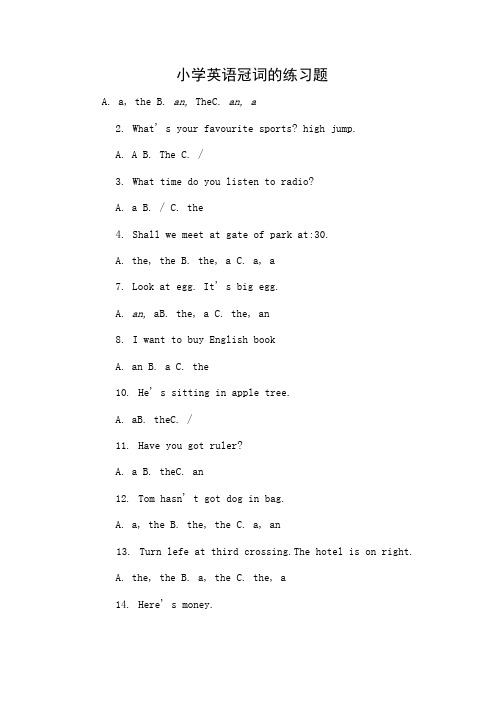
小学英语冠词的练习题A. a, theB. an, TheC. an, a2.What' s your favourite sports? high jump.A. AB. TheC. /3.What time do you listen to radio?A. aB. /C. the4.Shall we meet at gate of park at:30.A. the, theB. the, aC. a, a7.Look at egg. It' s big egg.A. an, aB. the, aC. the, an8.I want to buy English bookA. anB. aC. the10.He' s sitting in apple tree.A. aB. theC. /11.Have you got ruler?A. aB. theC. an12.Tom hasn' t got dog in bag.A. a, theB. the, theC. a, an13.Turn lefe at third crossing.The hotel is on right.A. the, theB. a, theC. the, a14.Here' s money.15.Can I take No. 2bus to the Garden Hotel?A. theB. aC. an16.Do you want orange coat.A. theB. anC. a17.Sometimes we watch TV in evening.A. aB. theC. /18.Would you like glass of milk?A. theB. anC. a19.Are Children have class?A. the, /B. the, aC. the, the20.What is lady doing?sun.A. the, aB. the, theC. a, the21.That' s nice picture. May I have look?A. the, a C. a, a22.We can see sun in afternoon.A. the, theB. a, /C. the, /23.There is some bread on plate.A. anB. aC. the 英语专项练习------------ 冠词练24.Have you got clock?25.Look at girl. She' s eating big apple.A. a, theB. the, aC. the, an26.One of athiete is my friend.A. aB. theC. an28.These clothes are same.A. aB. theC. an30.He' s athiete.A. aB. anC. the31.She swims for _________ hour every morning.A. aB. theC. an32.My father is ________ office worker.A. aB. anC. the33.Ann is ____ Australian girl. She is _________ pupil.A. anaB. ananC. aa34.Sunday is _______ first day of a week.A. aB. theC. an35.There is ____ empty box on the plate.A. aB. theC. an36._________ There' s___________________________ o ld manunder the tree. _____ man is my grandfather.A. anTheB. / TheC. a A37.Can you play __________ v iolin ?A. /B. theC. a38.Miss White is from ____________ U SA. She is _________ American.A. the /B. the anC. thea39.Is there ________ “e" in the word “meat" ?A. aB. theC. an40.Mrs Brown has not ______________ long hairA. /B. a C, the41.Whose eggs are they ? ________________eagle' s .A. AnB. AC. The42.Does Meihua live on __________ t hird floor ?A, anB. theC. a43.Which is ________ fifth day of a week ?A. theB. /C. an44.Do you like listen to __________ radio and listento ________ music ?A . / the B. the theC. / /4Janet has two friends. One is American,_____ other is Australian.A. /B. theC. . a46.We are going to climb ____________ mountain nextSunday .47.Are the tro users _______________ same or _____ differernt ?A. the theB. / theC. the /48.Please don' t talk in ____________ c lass .A . the B. / C. a49.Kate, don' t read in _________ bed and in ___________ sun .A. / theB. the /C. the the50.There are many shops in ____________ New Street .A. the B /C. this51.Is that _________ toy animal ?Yes , __________ animal is mine .A .atheB. an theC. a the52.________ y oung lady is our maths teacher .A. AB. T heC. /53.Look! some birds are flying in ______________ sky .A. /B. aC. the54.That' s ____________big apple . ___________ a pple is mine.A. an TheB. a TheC. / an55.Which is your fat her ? _________ man in brown .A. AB. TheC. /56.We are in __________ same grade , but in ____________ different classes .A. the theB. the /C. / the57.She' s ________ Chinese , her friend is _____________ American girl .A. / anB. / , /C. aan58.Let' s meet at eight in ________________ . morningA. thisB. theC. /59.Shall we go there by ____________ bike ? Sorry , I can' t ride __________ bikes .A. the /B. / theC. //60.Can you see ________ orange box ? Sorry , I canonly see _______ empty yellow boxes .A . the anB . an an C. an /61.Is Mr Smith ____________ art teacher of your school ?A. anB. aC. the62.Please read aloud ________ first lesson .A. aB. anC. the63.This is ______ empty bottle .64.Kate' s grandmother is __________ old worker.A. a B.anC. the65.There is shirt in the boxA. aB.anC.the66. We arein same class .A. aB.anC.the67.Jack is _______ Australian boy .A. aB. anC. the68._______ sun is in the sky .A. AB. AnC. The69.Take out __________ " e" from egg .A. aB. anC. the70.Which is Mr Black ? _________ tall one.A. aB. anC. the71.What' s _______ name of this dog ? Browny .A. aB. anC. the72.Don' t read in ___________ b ed .A. aB. /C. the73.He goes fishing for _____________ hour every day .A. aB. anC. the74.His father is office worker .75.There is _______ big apple tree in front of the house .A. aB. anC. the76.What' s in _______ second picture ? A dog .A. aB. anC. the77.Turn on __________ TV , please .A. aB. anC. the78.Don' t talk in __________ class .A. /B. anC. the79.My brother likes singing ___________ lot .A. aB. anC. the80.There is ______ piece of paper on the desk .A. aB. anC. the81.Thanks ______ lot .A. aB. anC. the82.Turn right at ___________ third crossing .A. aB. anC. the83.My uncle lives on __________ ground floor .A. aB. anC. the84.Let' s go to school by - _______________ bike .A. /B. anC. the85.Please play _______ piano once again .A. aB. anC. the86.We like play ______ football very much .A. /B. anC. the87.The black car is _________ English car .A. aB. anC. the88.Who' s that boy in ___________ b rown jacket .A. aB. anC. the89.This is ______ e-mail address .A. aB. anC. the90.My sister is ______ pupil of this school .A. aB. anC. the91.Is there a bookshop in ____________ Hill Street?A. /B. anC. the92.Can you see _____________ sun in the sky ?A. aB. anC. the93.Kate is ___________ eleven一year一old girl ?A. anB. aC. the94.We always say: “Lady __________ first" .A. /B. anC. the95.Please wash your hands __________ first.A. aB. /C. the96.He' s only child in his family.A. aB. /C. the97.old man is my uncle.A. aB. /C. the98.This ispen. Tt' sorange pen.A. a anB. / anC. the an99.Don' t read insun.A. aB. anC. the100.It' s time to go to school.A. aB. /C. the冠词一、定义冠词是一种虚词,本身不能单独使用,也没有词义,它用在名词的前面,帮助指明名词的含义。
(完整版)冠词专题(练习题含答案).docx
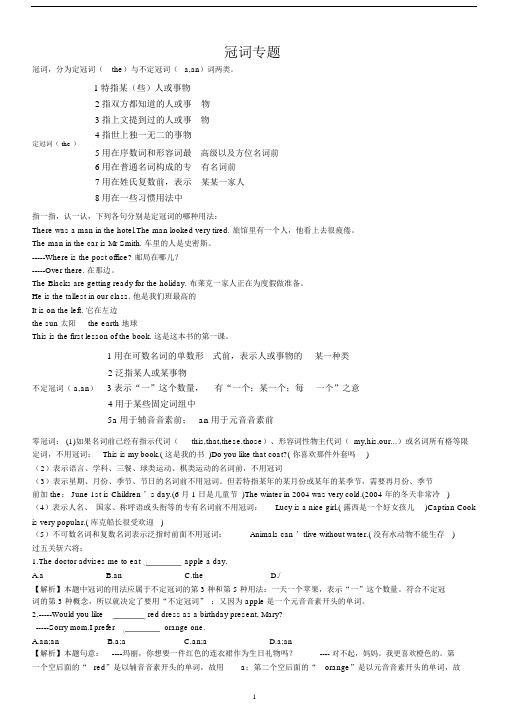
冠词专题冠词,分为定冠词(the)与不定冠词(a,an)词两类。
1特指某(些)人或事物2指双方都知道的人或事物3指上文提到过的人或事物4指世上独一无二的事物定冠词( the )5用在序数词和形容词最高级以及方位名词前6用在普通名词构成的专有名词前7用在姓氏复数前,表示某某一家人8用在一些习惯用法中指一指,认一认,下列各句分别是定冠词的哪种用法:There was a man in the hotel.The man looked very tired. 旅馆里有一个人,他看上去很疲倦。
The man in the car is Mr Smith. 车里的人是史密斯。
-----Where is the post office? 邮局在哪儿?-----Over there. 在那边。
The Blacks are getting ready for the holiday. 布莱克一家人正在为度假做准备。
He is the tallest in our class. 他是我们班最高的It is on the left. 它在左边the sun 太阳the earth 地球This is the first lesson of the book. 这是这本书的第一课。
1用在可数名词的单数形式前,表示人或事物的某一种类2泛指某人或某事物不定冠词( a,an)3表示“一”这个数量,有“一个;某一个;每一个”之意4用于某些固定词组中5a用于辅音音素前;an用于元音音素前零冠词: (1)如果名词前已经有指示代词(this,that,these.those)、形容词性物主代词(my,his,our...)或名词所有格等限定词,不用冠词:This is my book.( 这是我的书 )Do you like that coat?( 你喜欢那件外套吗)(2)表示语言、学科、三餐、球类运动、棋类运动的名词前,不用冠词(3)表示星期、月份、季节、节日的名词前不用冠词。
18、小学定冠词和不定冠词练习题

小学定冠词和不定冠词练习题1.在空格内填上 a 或 an1._____ear2.______actor3. _____hen4.______toy5. ______university6. ______elephant7.______hat8.______umbrella9.______rabbit10.______idea11.______hour 12_______ honest boy13.______interesting book 14.______easy question15.______orange dress16_______apple pie17_______X-ray machine18.______ice cream2.用 a,an,the或“/填”空1.________Washington is _______capital of ________United States of America.2.There is _________” A” on his paper.3. I ate ______apple .It’ s _______red apple.4._______tall man over there is my boss.5._______earth moves around sun.6.No news is ________good news.7.Have you visited Great Wall?8.They often play football after school.9.Children need love and attention.10.Are there any birds in sky?11.student in the third row is tallest in our class.12.Did you have breakfast this morning?13.Mr.White will go to Tokyo by air.14.By way,do you know old woman in glasses?3.选择填空1.Mom tells her little daughter old story every night.A. aB. /C. anD. theputer on the table is Susan’s.A. AB. AnC. TheD. /3.There is map of the world on wall.map is mine.A. a, a, AB. a, the, TheC. the, the, TheD. the, the, A4.Whites live on floor.A. /, threeB. A, thirdC. The, thirdD.The, the third5.Spring comes after winter.A./,/B.The, /C.The, theD.A, the6.I bought shoes yesterday.shoes are very beautiful.A. a, TheB. a pair of, TheC. the, TheD. a pair, The pair7.He was soldier in the Second World War.A. aB. anC. theD. /8.She can play and.A. the tennis, the guitarB. tennis, guitarC. the tennis, guitarD. tennis, the guitar9.I can see moon and clouds in the sky.A. the, aB. a, aC. the, /D. the, the10.“c” is in“cat“.s” is in“sat.”A. An, AnB. An, AC.A,AD. A, An11.Tian ’anmen Square is in Beijing.A./,/B.A,/C. The, /D. /, the12.—Can you tell me nearest bookshop?—Go straight and turn right at_______third crossing, and you will see it.A. the, aB. the, theC. a, theD. the, /随堂监测 A 组I. 在以下句子的空格中填上适合的冠词,不需要的地方用“/”表示:1.This is ______ old map. It is ______ useful map.2.We have no classes in ______ afternoon on _______ Saturday.3.______ spaceship flies at about eleven kilometers _______second.4.Beijing is ______ capital of ______ China. It is _______ beautiful city.5.Roman was not built in ______ day.6.Chinese is quite ______ difficult language for Mike.7.Many ______ students will take ______ active part in sports meet.8.There is ______ interesting picture on ______ wall.9.Jenny found ______ wallet lying on ______ground. ______ wallet was Mr. Blacks.10.Which is ______ biggest, ______ sun, ______ moon, or ______ earth?11.--- Which picture is more beautiful? --- ______one on ______ left, I think.12.--- Which is _____ way to ______ hospital?---Go down this road and turn left on ______ second crossing.13. _______ more, _______ better.14. _______ Turners are sitting at breakfast table.15. Joe Hill was _______ fighter for ______ working class.16.When was ______ People’ s Republic of China founded?17.In China ______ first English textbooks were published in _____late nineteenth century.18.After ______ breakfast he went to ______ school on ______ foot.19.______ Huanghe River lies in ______ north of China.20.He likes playing ______ football. His sister likes playing ______ piano.II.单项选择:1.上学A. go to schoolB. go to the school2.住院A, in the hospital B. in a hospital3.现在A. at the momentB. at a moment4.在讲堂上A. in classB. in a class5.在地球上A. on earthB. on an earth6.步行A. on footB. on the foot7.吃饭A. at a tableB. at the table8.乘公共汽车A. take busB. by bus9.在家A. at the homeB. at a home10. 在工作A. at workB. at the work11. 跳高A. jump highB. high jump12. 坐飞机A. by airB. by the airC. go to a school C. in hospitalC. at momentC. in the classC. on the earthC. on feetC. at tableC. by the busC. at homeC. at worksC. the high jumpC. on air13.乘火车A. by the trainB. by trainC. on train14.在校学习A. in the schoolB. in schoolC. in schools15.睡觉A. go to bedB. go to the bedC. go to a bed16.感冒A. have a coldB. have the coldC. have cold17.坐船A. by shipB. on shipC. by a ship18.玩得畅快A. have good timesB. have a good timeC. have good times19.事实上A. in the factB. in factsC. in fact21.从早到晚A. from morning to the eveningB. from morning to eveningC. from a morning to an evening随堂监测 B 组选择填空1.There is ______ old woman in the car.A. /B. theC. aD. an2.Shanghai is in _______ east of China.A. /B. anC. theD. a3.Bill is ______ English teacher. He likes playing ______ football.A. a, theB. an, theC. a, /D. /, /4. The museum is quite far. It will take you half _____ hour to go there by ______ bus.A. an, /B. an, aC. a, /D. /, /5. The story is ______ interesting. That means it is ______ interesting story.A. an, theB. the, a.C. /, anD. /, a6. Let’ s go for ______ walk, shall we?A. aB. anC. theD. /7. This is ______ interesting story-book and it is also ______ useful one.8. _______ woman over there is ______ popular teacher in our school.A. A, anB. The, aC. The , theD. A, the9. They passed our school ______ day before yesterday.A. anB. oneC. aD. the10.Australia is ______ English-speaking country.A. aB. anC. theD. /11.Don ’ t play ______ basketball here. It’ s dangerous.A. aB. anC. /D. the12.This is ______ apple. It’ s _______ big apple.A. an, aB. a, theC. a, anD. an, the13.--- Have you seen ______ bag? I left it here just now.--- Is it ______ one on the chair near the door?A. a, aB. the, theC. a, theD. the, a14.I have ______ blue coat.A. aB. anC. theD. some15.This is _____ orange. _______ orange is on the table.A. a, TheB. an, TheC. an, AnD. the, An16.Have you had ______ breakfast?A. aB. anC. theD. /17.He wondered when the doctor could finish_____ operation. A. a B. anC. theD. any18.After ______ supper, he stayed at home and played ______ violin.A. the, theB. /, theC. /, aD./,/19.There is ______ apple on the plate.A. aB. anC. theD. /20.He said that he got ______“ C” in the test.A. aB. anC. theD. /21.______ new bridge has been built over ______ Huangpu River.A. The, aB.A,/C. A, theD. An, an22.English is _______ useful language in ______ world.A. an, theB. a, theC. the, theD. an, an23.In the word“ cariage” _______“ r” is lost.A. theB. anC. aD. /24.With the help of his teacher he studied hard and got ______“ A” in theA. aB. anC. theD. one25.I have two dogs. ______ black one is two years old and ______ yellow one is three years old.A. A, aB. The, aC. The, theD. A. the26.Li Dan can play ______ piano very well.A. /B. aC. anD. the27.What ______ interesting film it is! I like ______ film very much.A. a, theB. a, aC. an, theD. The, /28. ______ tall man over there is our ______ English teacher.A. A, theB. The, aC. A, anD. The, /小学英语冠词的用法提升专题精讲及同步练习冠词虽小,只有a,an 和 the 三个,但倒是历年各地考试必考语言点之一。
定冠词练习题(打印版)
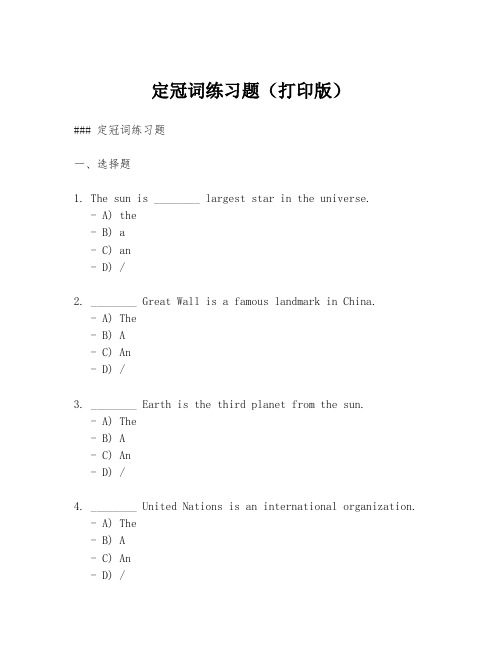
定冠词练习题(打印版)### 定冠词练习题一、选择题1. The sun is ________ largest star in the universe.- A) the- B) a- C) an- D) /2. ________ Great Wall is a famous landmark in China.- A) The- B) A- C) An- D) /3. ________ Earth is the third planet from the sun.- A) The- B) A- C) An- D) /4. ________ United Nations is an international organization. - A) The- B) A- C) An- D) /5. ________ Nile is the longest river in Africa.- A) The- B) A- C) An- D) /二、填空题6. ________ moon orbits around ________ Earth.- A) The; the- B) A; a- C) The; a- D) A; the7. ________ wind is blowing from ________ east.- A) The; the- B) A; a- C) The; a- D) A; the8. ________ Shakespeare is considered ________ greatest playwright in English literature.- A) The; a- B) A; the- C) The; the- D) A; a9. ________ Mount Everest is the highest mountain in the world.- A) The- C) An- D) /10. ________ Amazon rainforest is the largest rainforest in the world.- A) The- B) A- C) An- D) /三、判断题11. The use of the definite article "the" is correct in the sentence "The moon is made of green cheese."- True- False12. You would say "I have a dog" when you're talking about your own pet.- True- False13. "The Eiffel Tower" is the correct way to refer to the famous tower in Paris.- True- False14. "A new moon" is a phrase that refers to the first visible crescent of the moon after the full moon.- True15. "The Great Barrier Reef" is the only living structure visible from space.- True- False答案:1. A2. A3. A4. A5. A6. A; the7. C; the8. C; the9. A10. A11. False12. True13. True14. True15. False。
- 1、下载文档前请自行甄别文档内容的完整性,平台不提供额外的编辑、内容补充、找答案等附加服务。
- 2、"仅部分预览"的文档,不可在线预览部分如存在完整性等问题,可反馈申请退款(可完整预览的文档不适用该条件!)。
- 3、如文档侵犯您的权益,请联系客服反馈,我们会尽快为您处理(人工客服工作时间:9:00-18:30)。
冠词重点知识归纳及讲解(一)概说1.冠词是一种虚词,不能独立担任一个成分,只能附着在一个名词上,帮助说明其词义。
英语中有两个冠词:1)定冠词the2)不定冠词a/an定冠词the通常读作[],在元音前读作[i],特别强调或单念时读作[i:]。
不定冠词在元音音素开始的单词前用an这个形式,读作[n];在其他情况下则使用a,读作[]。
2.冠词的基本意义不定冠词a/an与数词one同源,表示“一个”的意思,用在可数名词单数前。
例如:She is a nurse. 她是个护士。
He is an Englishman, with an Irish wife.他是一位英国人,有一个爱尔兰妻子。
定冠词the,与this同源,有“这(那)个”的意思,但比较弱,表示一(几)个特定的人或东西,有时可译作“这个(些)”或“那个(些)”。
例如:That’s the book you want. 这就是你要的那本书。
Who’s the young man over there? 那边那个年轻人是谁?但在很多情况下,“这”或“那”这类词在译文中并不出现。
例如:Put it on the table. 把它放在桌上。
Shut the door, please. 请把门关上。
3.特指和泛指一般来说,名词有特指和泛指两种情况,请比较下面的句子:A gentleman is asking to see you. 有位先生要求见你。
(泛指)Ask the gentleman to come in. 请那位先生进来。
(特指)在特指时一般前面要加定冠词,而泛指时则有三种情况:1)在可数名词单数前加不定冠词。
例如:She sent me a postcard 她寄给我一张明信片。
2)在可数名词复数前可不加冠词,可使用some, any这类词。
例如:These are new words. 这些是生词。
She sent me some flowers. 她送给我一些花。
3)在不可数名词前多不加什么,有时也可加some, any等。
例如:It’s lovely weather. 天气真好。
Do you want any sugar in your tea? 你茶里要放点糖吗?Give us some help. 给我们一些帮助。
(二)不定冠词的基本用法1.泛指某一类人或事物中的一个,代表某一类别(不一定译为“一”)如:His father is a doctor. 他父亲是医生。
2.代表某一类人或事物,相当于any(+名词)(不必译为“一”,但必须用a,表示类别)如:A horse is a useful animal. 马是有用的动物。
3.指某人或某物(不是指某一类),但不具体说明何人或何物(一般译为“一”)如:This book was written by a worker. 这本书是一位工人写的。
4.表示数量,有“一”的意思,但数的概念没有one强烈(一般译为“一”)如:Wait a moment. 等一下。
5.表示单位,相当于“每”的意思如:We have three meals a day. 我们每日吃三餐。
6.用于某此固定词组中例如:a few, a little, a bit (of), a lot of等。
(三)定冠词的基本用法1.特指某(些)人或某(些)事物如:Give me the book. 把那本书给我。
2.指谈话双方都知道的人或事物如:Where is the doctor? 医生在哪儿?3.再次提到上文提到过的人或事物如:I bought a dictionary yesterday. The dictionary is at home.昨天我买了一本词典。
词典在家里。
4.用在大家所熟悉的、世界上独一无二的事物如:The earth is bigger than the moon, but smaller than the sun.地球比月亮大,但比太阳小。
5.用在序数词和形容词最高级前如:Mr Wang teaches the first class. 王先生上第一节课。
Of all the stars the sun is the nearest to the earth.在所有的恒星中,太阳离地球最近。
6.用在单数可数名词,表示某一类人或事物如:The horse is a useful animal. 马是有用的动物。
7.与下列专有名词连用1)在江、河、湖、海、群岛、山脉的名称前如:the Changjiang River, the Great Lake2)在姓氏的复数名词前,表示夫妇二人或全家人如:The Greens are sitting at the breakfast table. 格林一家人正围坐在早餐桌旁。
8.和某些形容词连用,表示一类人如:the old 老人the young 年轻人the rich 富人the poor 穷人the sick 病人the dead 死人9.在一些习惯说法中the east (west, south, north)in the morning (afternoon, evening)on the left (right)in the endgo to the cinema(四)不用冠词的几种情况1.在专有名词,抽象名词和物质名词前如:Have you ever been to Shanghai? 你到过上海吗?We love science. 我们爱好科学。
2.在表示一类人或事物的复数名词前如:Girls can be scientists. 女孩子可以当科学家。
3.在季节、月份、星期、一日三餐的名称前如:It is hot in summer. 夏天天气热。
It’s Tuesday, August the 22nd. 今天是八月二十二日,星期三。
Have you had breakfast? 你吃过早饭没有?4.称呼语或表示头衔,职务的名词前如:What’s the matter with you, Mike? 怎么啦,迈克?He is headmaster of our school. 他是我们学校的校长。
5.学科和球类运动的名称前如:We study English. 我们学习英语。
Do you like to play football? 你喜欢踢足球吗?6.名词前已有用作定语的this, that my, your, some, any, no, whose, every, each等代词时,不用冠词如:That is her bike.那是她的自行车。
Each student in his class studies hard. 这个班的每个学生都努力学习。
7.在某些固定词组的名词前如:at home, at night, after school, by bus, in bed, in town, in front of, go to school, go to bed 等。
小学定冠词和不定冠词练习题1.在空格内填上a或an1. _____ear2.______actor3. _____hen4. ______toy5. ______university6. ______elephant7. ______hat 8.______umbrella 9.______rabbit10.______idea 11.______hour 12_______ honest boy13.______interesting book 14.______easy question15.______orange dress 16_______apple pie17_______X-ray machine 18.______ice cream2.用a,an,the或“/”填空1.________Washington is _______capital of ________United States of America.2.There is _________”A” on his paper.3. I ate ______apple .It’s _______red apple.4._______tall man over there is my boss.5._______earth moves around sun.6.No news is ________good news.7.Have you visited Great Wall?8.They often play football after school.9.Children need love and attention.10.Are there any birds in sky?11. student in the third row is tallest in our class.12.Did you have breakfast this morning?13.Mr.White will go to Tokyo by air.14.By way,do you know old woman in glasses?3.选择填空1.Mom tells her little daughter old story every night.A. aB. /C. anD. the2. computer on the table is Susan’s.A. AB. AnC. TheD. /3.There is map of the world on wall. map is mine.A. a, a, AB. a, the, TheC. the, the, TheD. the, the, A4. Whites live on floor.A. /, threeB. A, thirdC. The, thirdD.The, the third5. Spring comes after winter.A. /, /B.The, /C.The, theD.A, the6.I bought shoes yesterday. shoes are very beautiful.A. a, TheB. a pair of, TheC. the, TheD. a pair, The pair7.He was soldier in the Second World War.A. aB. anC. theD. /8.She can play and .A. the tennis, the guitarB. tennis, guitarC. the tennis, guitarD. tennis, the guitar9.I can see moon and clouds in the sky.A. the, aB. a, aC. the, /D. the, the10. “c” is in “cat.”“s” is in “sat.”A. An, AnB. An, AC. A, AD. A, An11. Tian’anmen Square is in Beijing.A. /, /B. A, /C. The, /D. /, the12.—Can you tell me nearest bookshop?—Go straight and turn right at_______third crossing, and you will see it.A. the, aB. the, theC. a, theD. the, /冠词随堂监测A组I. 在下列句子的空格中填上适当的冠词,不需要的地方用“/”表示:1. This is ______ old map. It is ______ useful map.2. We have no classes in ______ afternoon on _______ Saturday.3. ______ spaceship flies at about eleven kilometers _______second.4. Beijing is ______ capital of ______ China. It is _______ beautiful city.5. Roman was not built in ______ day.6. Chinese is quite ______ difficult language for Mike.7. Many ______ students will take ______ active part in sports meet.8. There is ______ interesting picture on ______ wall.9. Jenny found ______ wallet lying on ______ground. ______ wallet was Mr. Black’s.10. Which is ______ biggest, ______ sun, ______ moon, or ______ earth?11. --- Which picture is more beautiful? --- ______one on ______ left, I think.12. --- Which is _____ way to ______ hospital?--- Go down this road and turn left on ______ second crossing.13. _______ more, _______ better.14. _______ Turners are sitting at breakfast table.15. Joe Hill was _______ fighter for ______ working class.16. When was ______ People’s Republic of China founded?17. In China ______ first English textbooks were published in _____late nineteenth century.18. After ______ breakfast he went to ______ school on ______ foot.19. ______ Huanghe River lies in ______ north of China.20. He likes playing ______ football. His sister likes playing ______ piano.II. 单项选择:1. 上学A. go to schoolB. go to the schoolC. go to a school2. 住院A, in the hospital B. in a hospital C. in hospital3. 此刻A. at the momentB. at a momentC. at moment4. 在课堂上A. in classB. in a classC. in the class5. 在地球上A. on earthB. on an earthC. on the earth6. 步行A. on footB. on the footC. on feet7. 吃饭A. at a tableB. at the tableC. at table8. 乘公共汽车A. take busB. by busC. by the bus9. 在家A. at the homeB. at a homeC. at home10. 在工作A. at workB. at the workC. at works11. 跳高A. jump highB. high jumpC. the high jump12. 坐飞机A. by airB. by the airC. on air13. 乘火车A. by the trainB. by trainC. on train14. 在校学习A. in the schoolB. in schoolC. in schools15. 睡觉A. go to bedB. go to the bedC. go to a bed16. 感冒A. have a coldB. have the coldC. have cold17. 乘船A. by shipB. on shipC. by a ship18. 玩得痛快A. have good timesB. have a good timeC. have good times19. 事实上A. in the factB. in factsC. in fact21. 从早到晚A. from morning to the eveningB. from morning to eveningC. from a morning to an evening随堂监测B组选择填空1. There is ______ old woman in the car.A. /B. theC. aD. an2. Shanghai is in _______ east of China.A. /B. anC. theD. a3. Bill is ______ English teacher. He likes playing ______ football.A. a, theB. an, theC. a, /D. /, /4. The museum is quite far. It will take you half _____ hour to go there by ______ bus.A. an, /B. an, aC. a, /D. /, /5. The story is ______ interesting. That means it is ______ interesting story.A. an, theB. the, a.C. /, anD. /, a6. Let’s go for ______ walk, shall we?A. aB. anC. theD. /7. This is ______ interesting story-book and it is also ______ useful one.A. a, aB. an, anC. an, aD. a, an8. _______ woman over there is ______ popular teacher in our school.A. A, anB. The, aC. The , theD. A, the9. They passed our school ______ day before yesterday.A. anB. oneC. aD. the10. Australia is ______ English-speaking country.A. aB. anC. theD. /11. Don’t play ______ basketball here. It’s dangerous.A. aB. anC. /D. the12. This is ______ apple. It’s _______ big apple.A. an, aB. a, theC. a, anD. an, the13. --- Have you seen ______ bag? I left it here just now.--- Is it ______ one on the chair near the door?A. a, aB. the, theC. a, theD. the, a14. I have ______ blue coat.A. aB. anC. theD. some15. This is _____ orange. _______ orange is on the table.A. a, TheB. an, TheC. an, AnD. the, An16. Have you had ______ breakfast?A. aB. anC. theD. /17. He wondered when the doctor could finish _____ operation. A. a B. anC. theD. any18. After ______ supper, he stayed at home and played ______ violin.A. the, theB. /, theC. /, aD. /, /19. There is ______ apple on the plate.A. aB. anC. theD. /20. He said that he got ______ “ C” in the test.A. aB. anC. theD. /21. ______ new bridge has been built over ______ Huangpu River.A. The, aB. A, /C. A, theD. An, an22. English is _______ useful language in ______ world.A. an, theB. a, theC. the, theD. an, an23. In the word “ cariage” _______ “ r” is lost.A. theB. anC. aD. /24. With the help of his teacher he studied hard and got ______ “ A” in the test.A. aB. anC. theD. one25. I have two dogs. ______ black one is two years old and ______ yellow one is three years old.A. A, aB. The, aC. The, theD. A. the26. Li Dan can play ______ piano very well.A. /B. aC. anD. the27. What ______ interesting film it is! I like ______ film very much.A. a, theB. a, aC. an, theD. The, /28. ______ tall man over there is our ______ English teacher.A. A, theB. The, aC. A, anD. The, /小学英语冠词的用法提高专题精讲及同步练习冠词虽小,只有a,an和the三个,但却是历年各地考试必考语言点之一。
